

CarExpert.com.au
The CarExpert team's favourite cars of 2025
3 Hours Ago
Two of the best $65,000 seven-seat SUVs in the business go head-to-head. Which one suits you more?

Senior Contributor
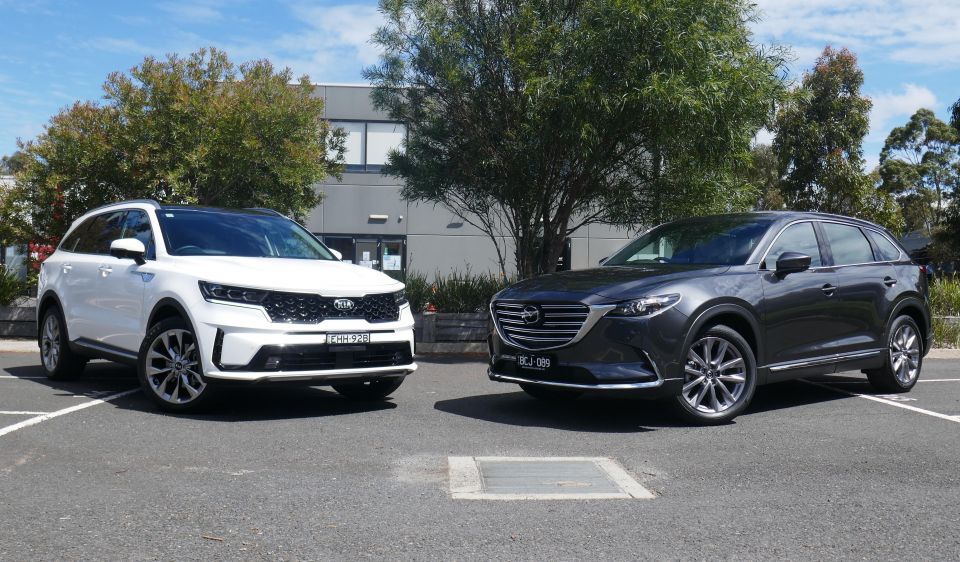

Senior Contributor
The brand new Kia Sorento has been greeted by acclaim since its launch during September this year. But if its maker wants to win the hearts, minds, and money of the nation’s mums and dads, it needs to overcome some stiff competition.
This includes the Santa Fe from parent brand Hyundai, and the top-selling Toyota Kluger. Then there’s the Mazda CX-9, which has become a ‘semi-premium’ favourite in the second-generation form tested here.
If you’re cross-shopping family SUVs, then this pair is almost certainly on your shopping list. Which one fits your specific needs best? The Kia is clearly ahead when it comes to the latest tech, but the Mazda has a more luxurious feel. Let’s explain.
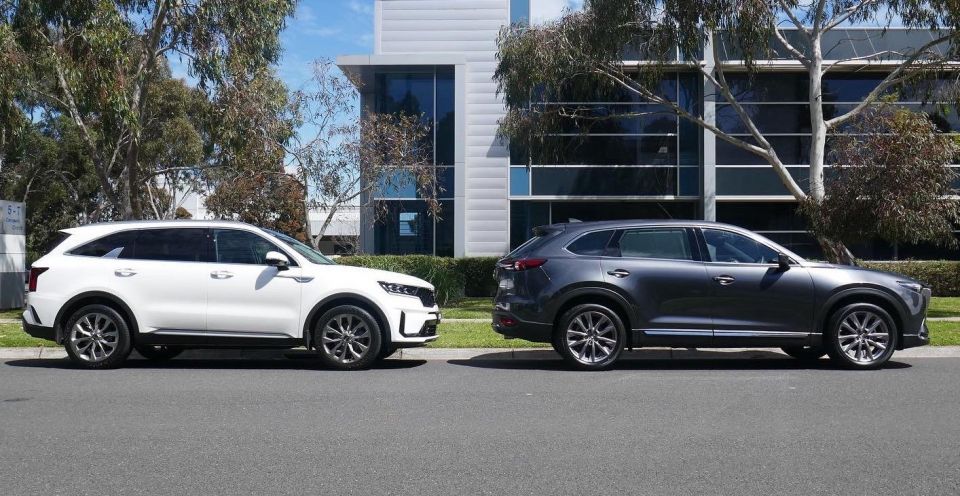
In order to best demonstrate the full scope of available features, we’ve borrowed a range-topping Sorento GT-Line for this head-to-head showdown. It lines up best with the CX-9 GT grade, which sits one rung beneath the flagship Azami variant.
Both come with national drive-away pricing which, at the time of writing, was $64,990 for the Kia and $65,990 for the Mazda. For those on a tighter budget, the Kia Sorento range kicks off at $46,990 and the Mazda CX-9 range from $45,920.
| Kia Sorento GT-Line | Mazda CX-9 GT | |
|---|---|---|
| List price | $63,070 | $65,720 |
| Drive-away* | $64,990 | $65,990 |


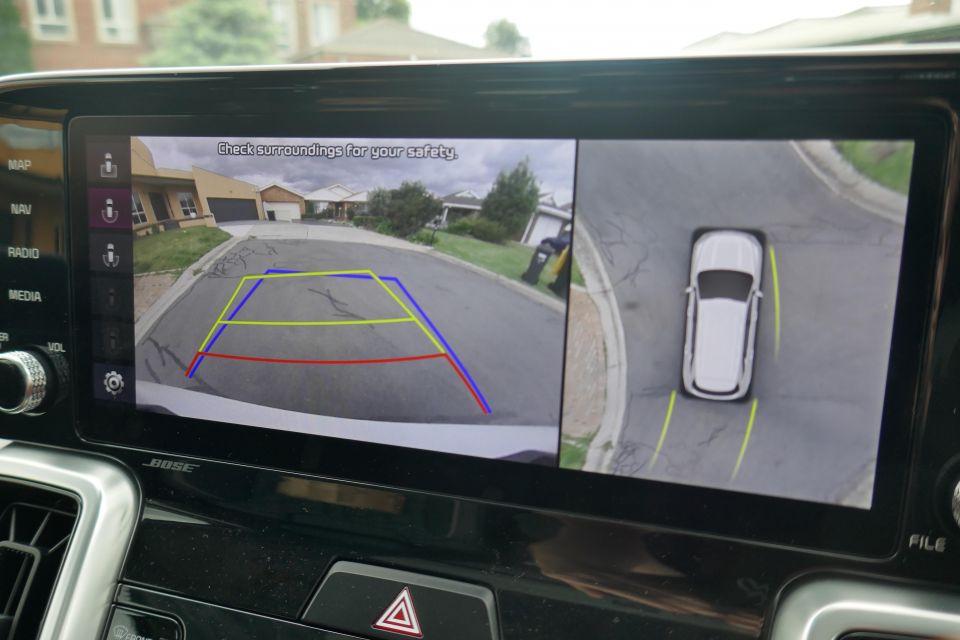
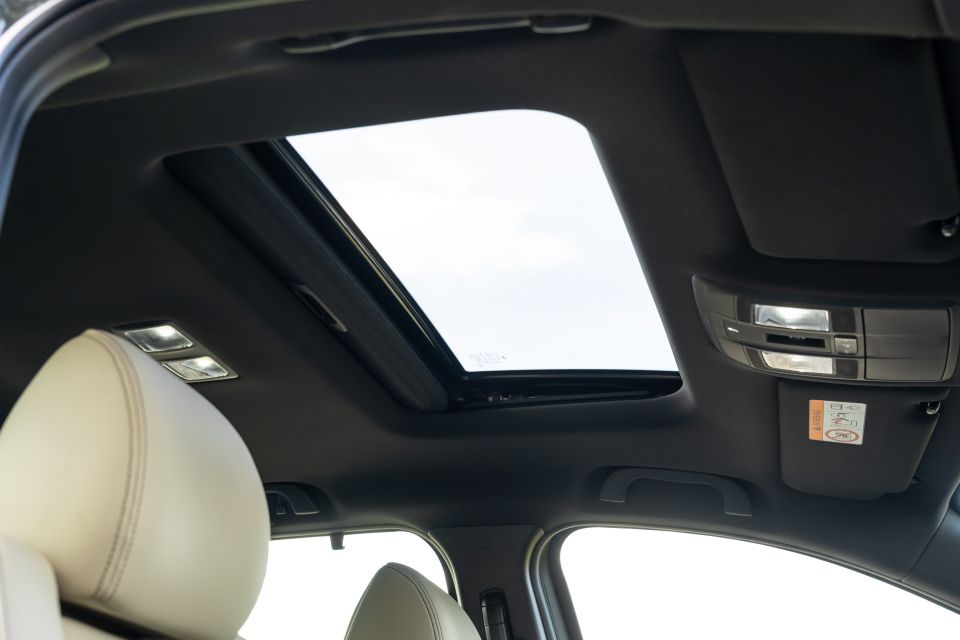
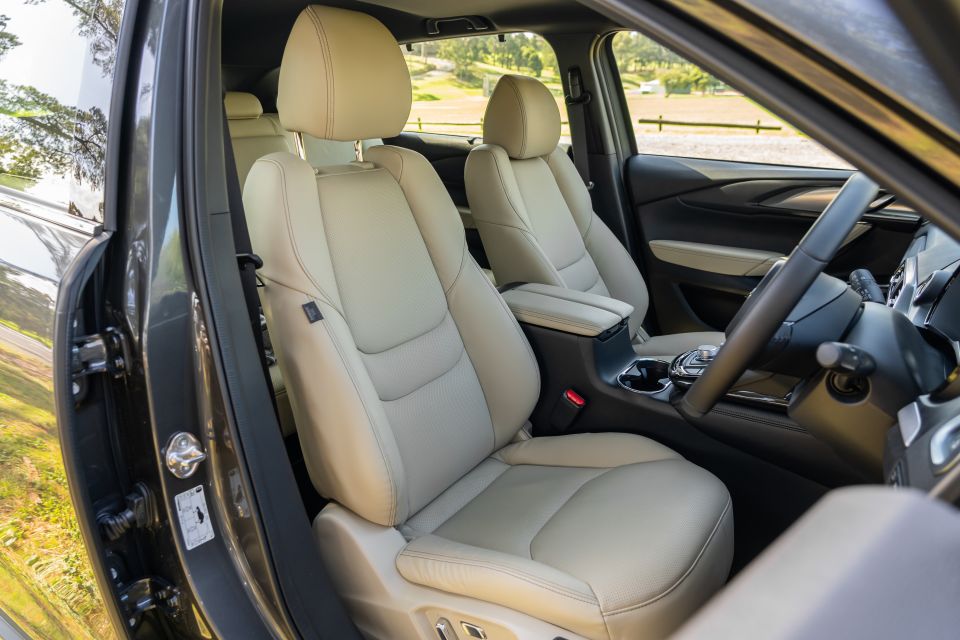
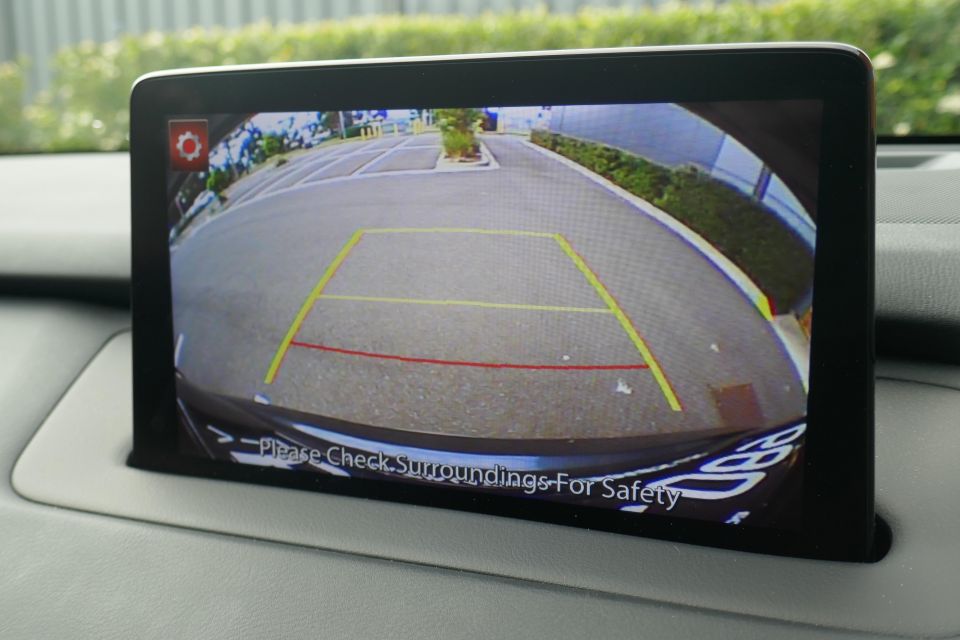
Let’s start with features found in both vehicles.
On the outside both the Sorento GT-Line and CX-9 GT come with a powered hands-free tailgate, hands-free proximity key access, a sunroof, roof rails, LED headlights and tail lights, auto-folding side mirrors, rain-sensing wipers, and 20-inch alloy wheels.
Inside both get leather seat trim with power adjustment and heating for the front two occupants, plus heated seat bases for the outboard middle-row pews. Each also gets three-zone climate control, USB point access for all three seating rows, a head-up display projecting on the windscreen, Apple CarPlay and Android Auto, factory sat-nav, and Bose 12-speaker sound systems.
Above this the Kia adds a heated steering wheel, a Qi wireless phone charger, fully digital driver’s instruments, a larger touchscreen (12.3-inch versus 9.0-inch), and a full-sized alloy spare wheel instead of a space-saver. So it wins when it comes to creature comforts.
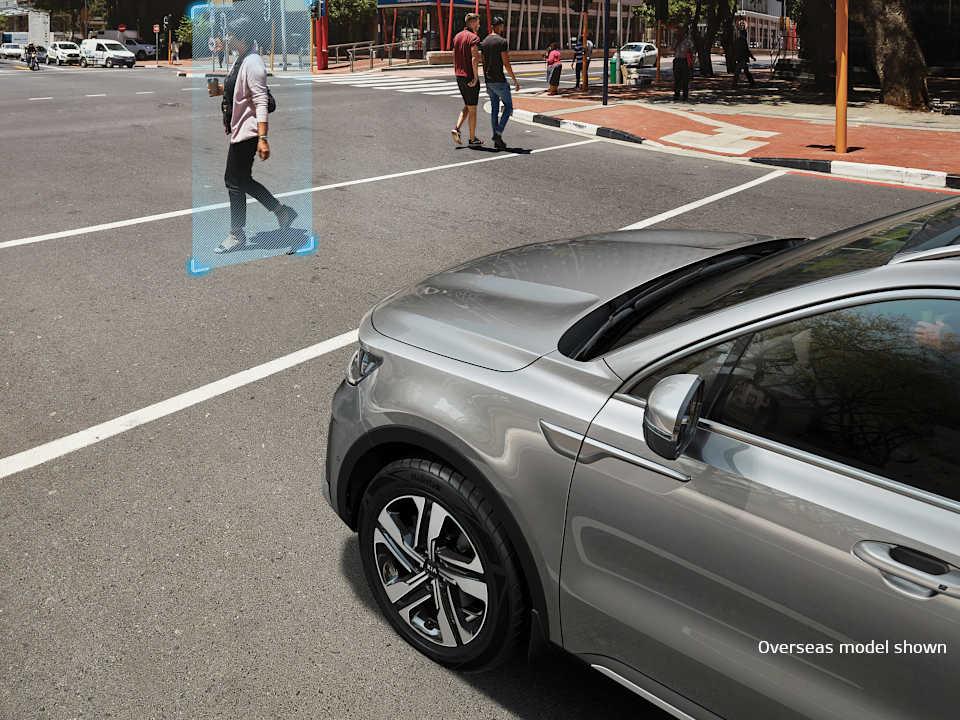
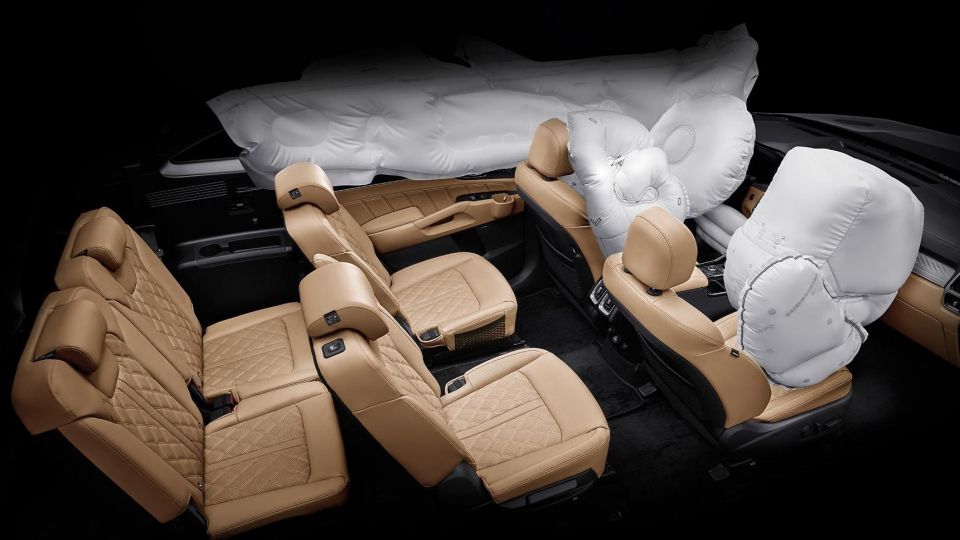
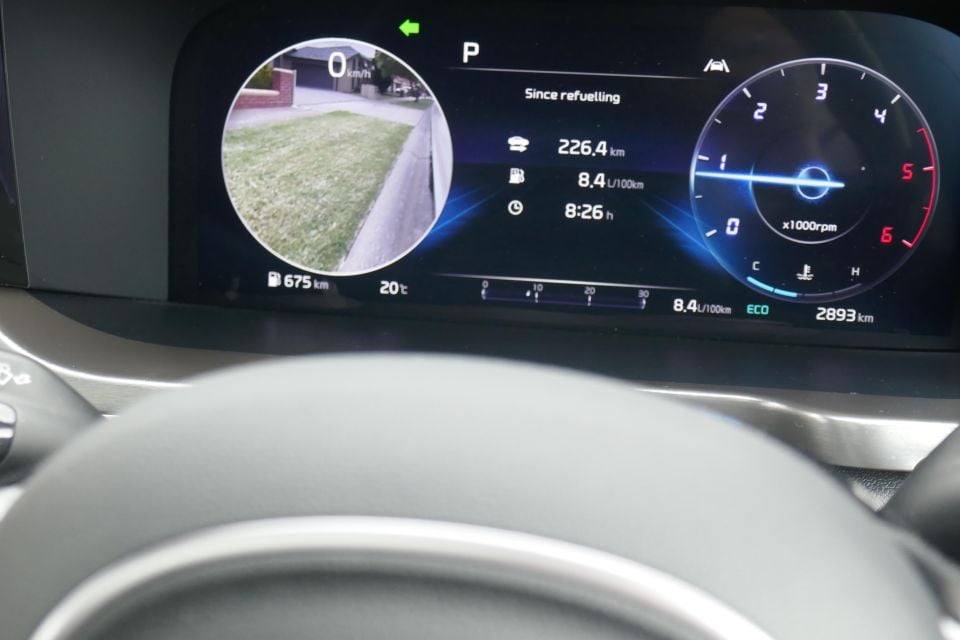
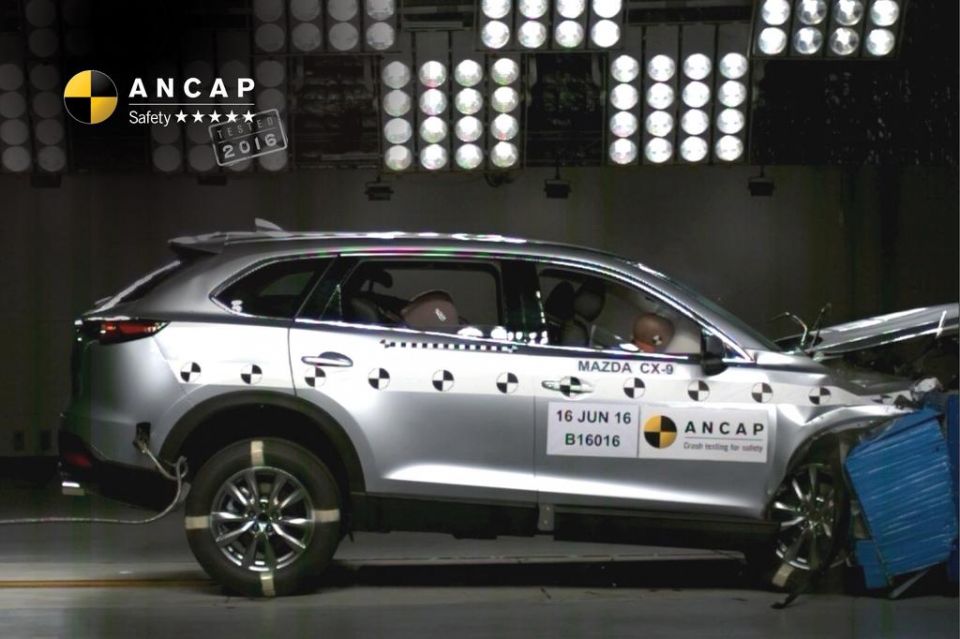
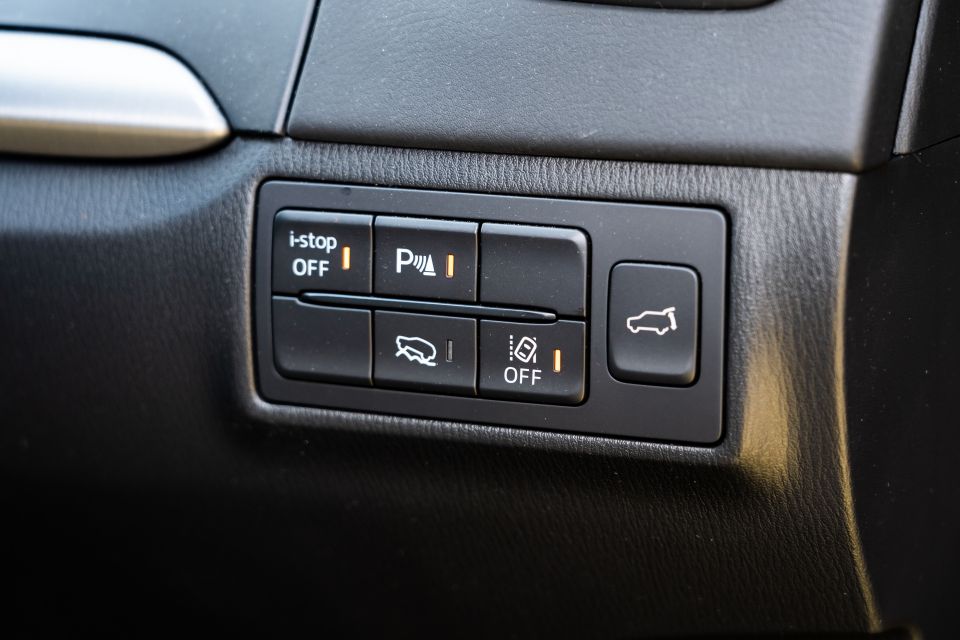
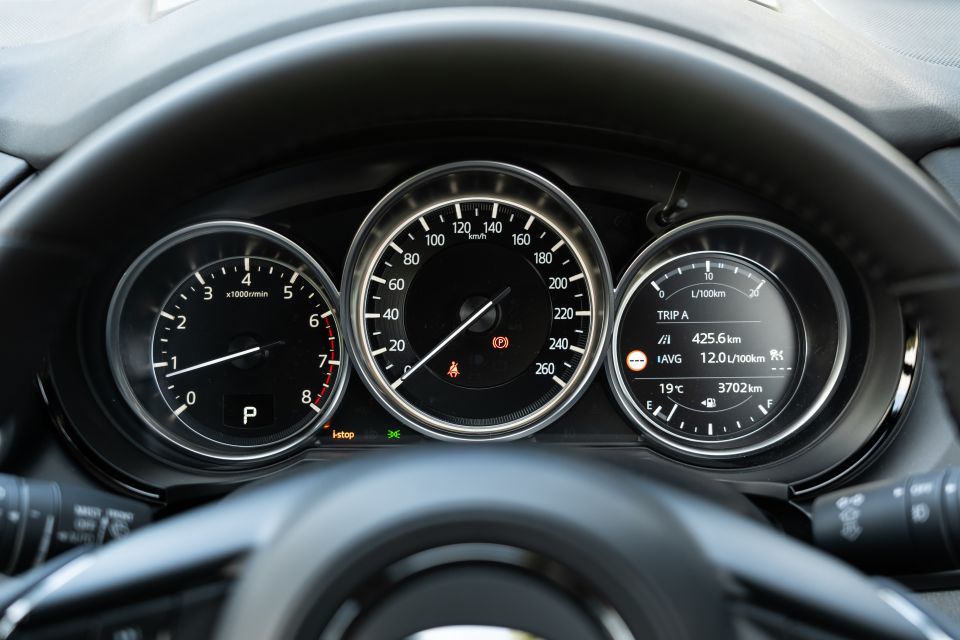
Both vehicles come with autonomous emergency braking (AEB). The Kia’s alone can detect pedestrians and cyclists, and is operational at junctions. The Mazda’s works in reverse.
Both come with active lane-keeping assist functions to nudge you back between the road lines, rear cross-traffic alert, and active cruise control.
Both come with blind-spot monitoring lights in the side mirror, but the Kia’s system alone is active (meaning it uses audible feedback and braking to help potentially mitigate merging collisions), and it also displays a high-resolution side-camera-view in the instrument panel every time you indicate.
The Kia also has a 360-degree camera in place of the Mazda’s rear-view camera, a driver’s knee airbag, and Safe Exit Assist that alerts you if an occupant is about to open a door into an oncoming, parallel cyclist.
On the other hand, the Mazda’s side head-protecting curtain airbags cover part of the third-row, whereas the Kia’s specifically only cover rows one and two. Which is worth noting if you’re regularly carrying six or seven people.
The Mazda attained a five-star ANCAP crash rating in 2016. The Kia’s test results are not yet in, with COVID-19 delaying 2020’s tests.
We understand they should be announced before the end of this year.
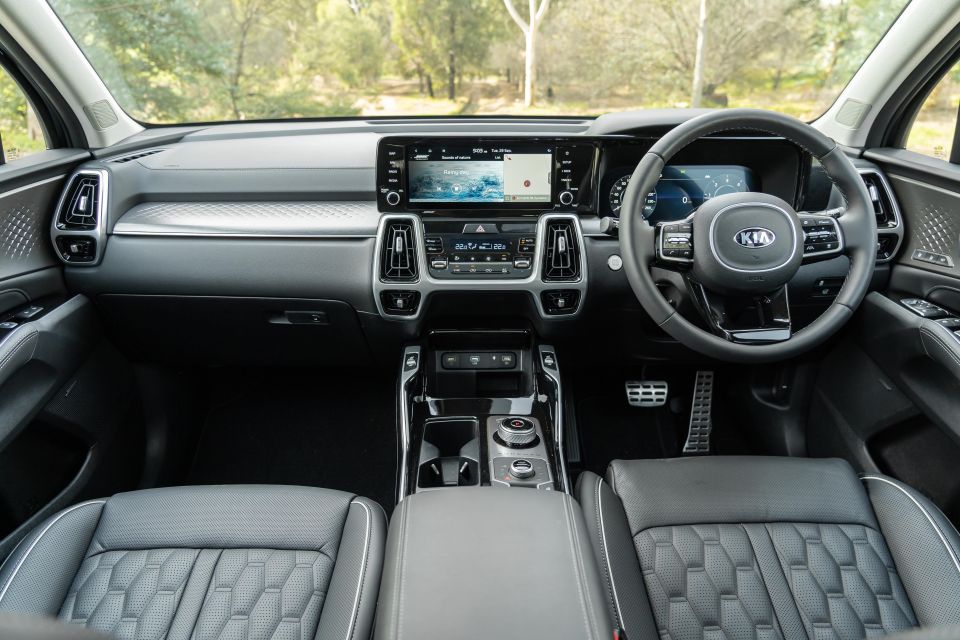
Kia Sorento GT-Line
The Kia makes a great first impression. The digital cluster is informative and adopts new aesthetics contingent on the driving mode you’ve selected. The head-up display with speed and navigation data is a great tool as well, particularly at night.
The Nappa leather used on the seats feels hard wearing and tactile, and both front occupants get heating and ventilation as well as power adjustments. The driver also gets two memory presets and power lumbar adjustment.
Storage options include multiple cubbies along the transmission tunnel, a deep centre console, bottle-holding door bins, and a glovebox. The use of a rotary dial gear shifter and electric parking brake seems to free up some storage space.
The build quality is hard to fault, and some nice design touches include the brushed metal-like trim on the dash, softly backlit door inserts, padded leather-like arm rests and door cards, and soft-touch dash are premium in feel.
I’m not so enamoured with the overuse of glossy black plastic along the fascia and tunnel though. It looks great in the showroom but 10 minutes on the road will find it covered in dust, smudges and scratches. And sun glare.
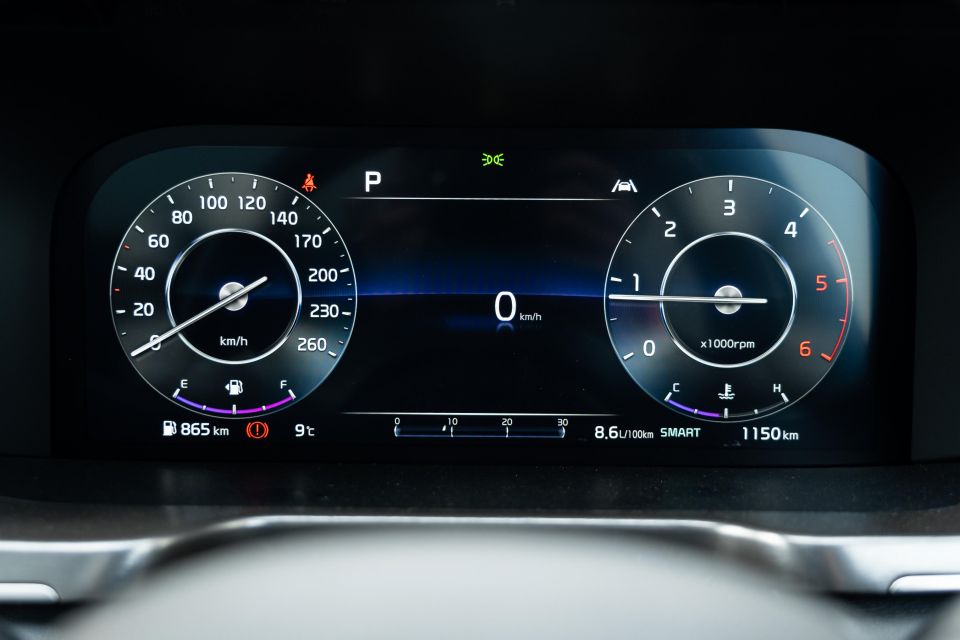

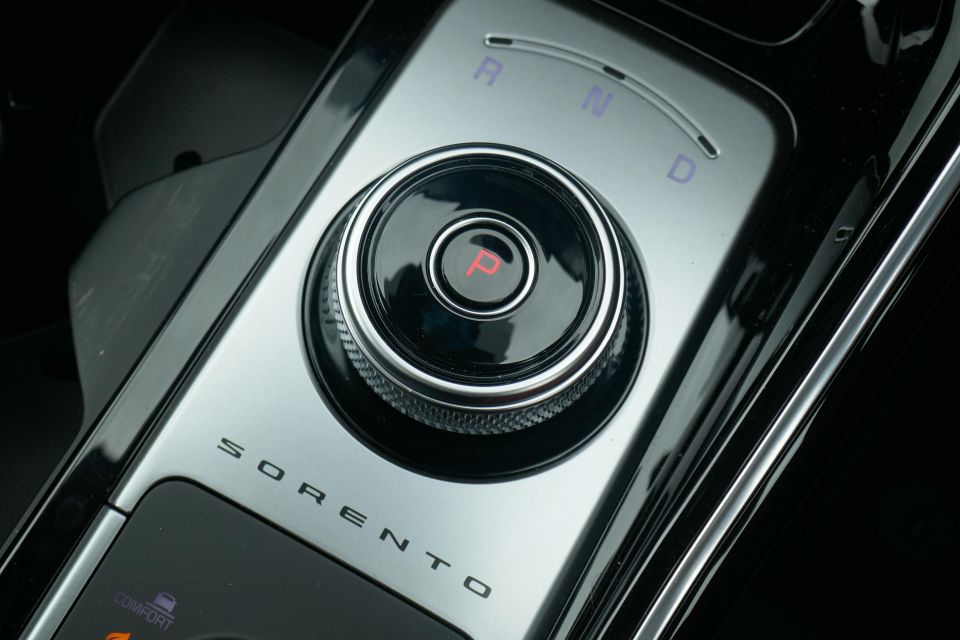
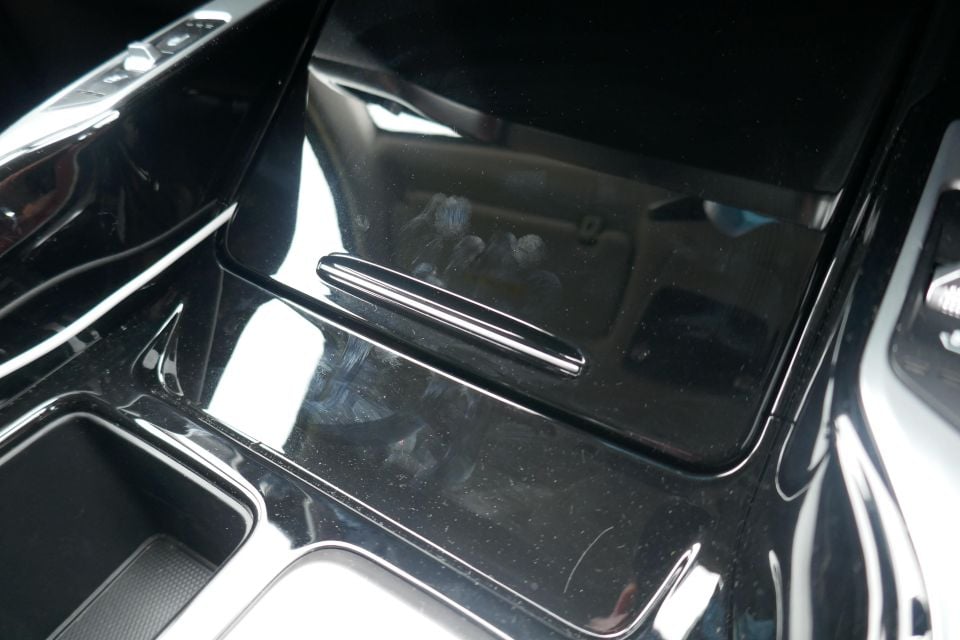
The centre screen sits up high and is well integrated. There are touchpoint shortcuts to go to functions such as maps or media, which reduces the time spent digging through menus. The 360-degree camera also offers fantastically clear resolution to aid parking.
The Bose system’s audio quality is excellent, with good control over the bass and little distortion to my ears.
There are some really cool functions. There are 64 different interior light signatures, and an intercom system to communicate with third row occupants with one press of the touchscreen – once you’ve saved this function as your designated shortcut.
But there are also some gimmicks. Who really wants a voice memo recorder in their car? And are ‘sounds of nature (Lively Forest for example) piped through the speakers something you’ll use more than once? Maybe.
The back doors don’t open 90 degrees, but the aperture is fine. The doors have nifty pull-up retracting sun shades, high-mounted cup holders, and bottle bins, and the material quality is as solid as you find up front. The doors close with a solid thunk.
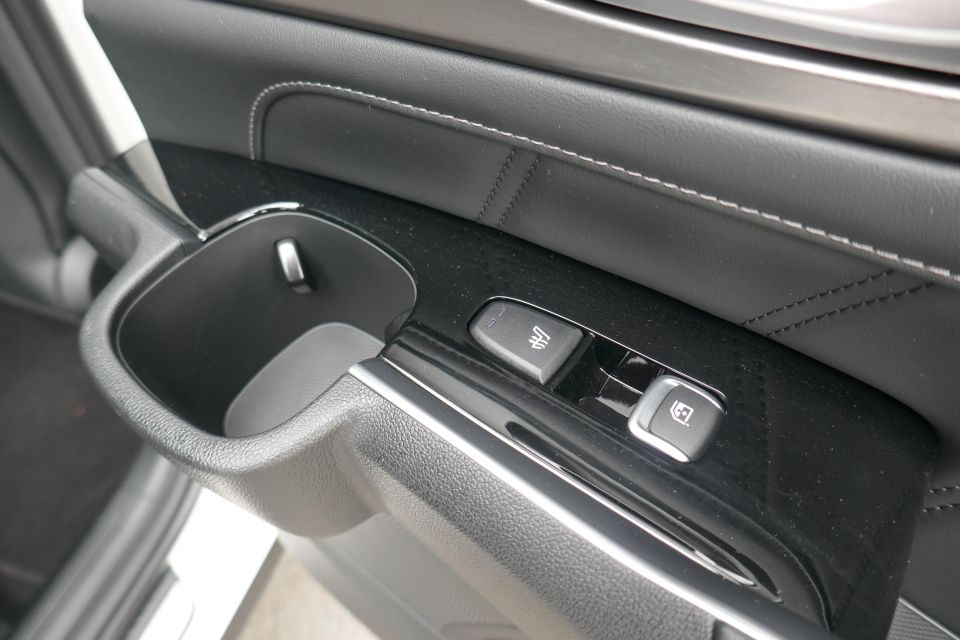
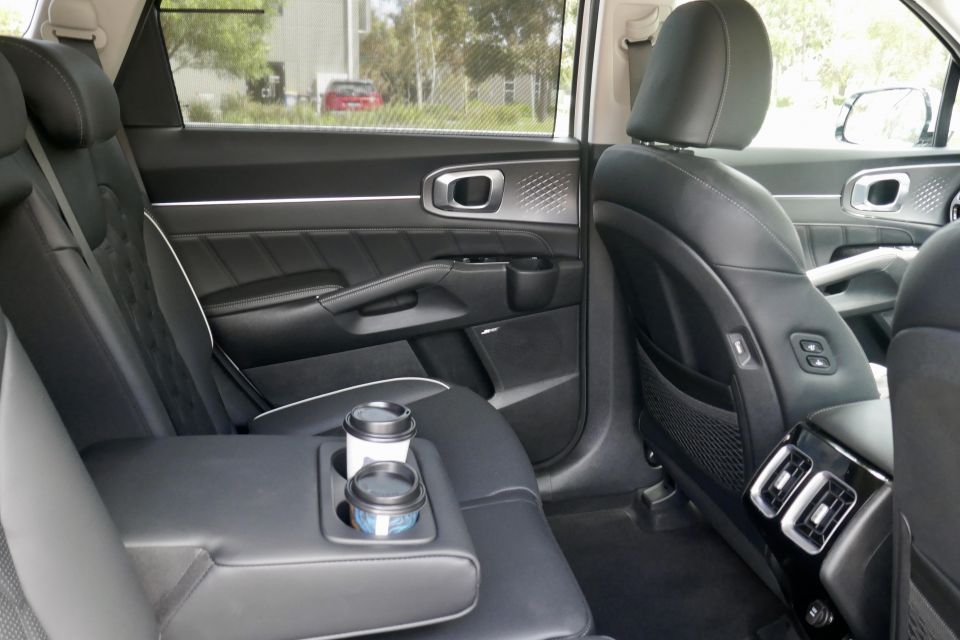
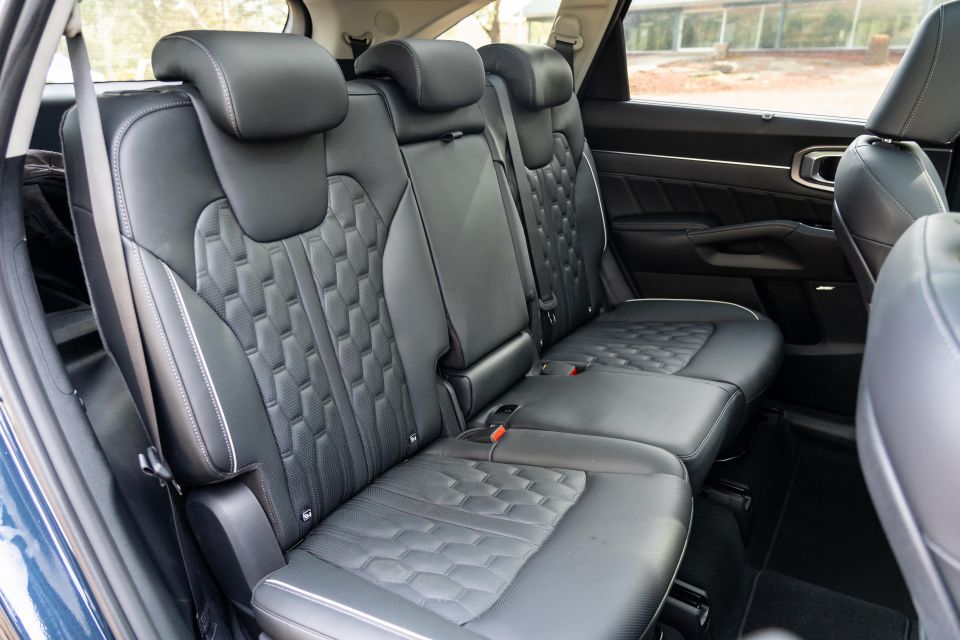

Each outboard middle-row seat is heated, a function controlled by button on each rear door. Legroom and shoulder room were excellent – I’m 194cm or 6 foot 4 inches in the old money – and despite that huge sunroof, there’s headroom.
Middle-row occupants are treated to three USB points (one in each front seat’s side, one behind the centre console), air vents, and a 12V socket. There are also LED reading lights, and spring-loaded overhead grab handles.
The middle seat’s backrest flips down to become an armrest with integrated cup holders for outboard occupants. This middle perch is suited to kids more than adults, though the lack of a notable driveshaft hump is most welcome.
You can recline each portion of the split-folding middle-row bench (60 per cent on the left, 40 per cent on the right), and each portion slides forward and backwards on rails.
Access to the third row of seats is as simple as pushing one button mounted on the base of the left-hand-side middle seat. This slides and tilts the larger, kerbside portion of the split bench.
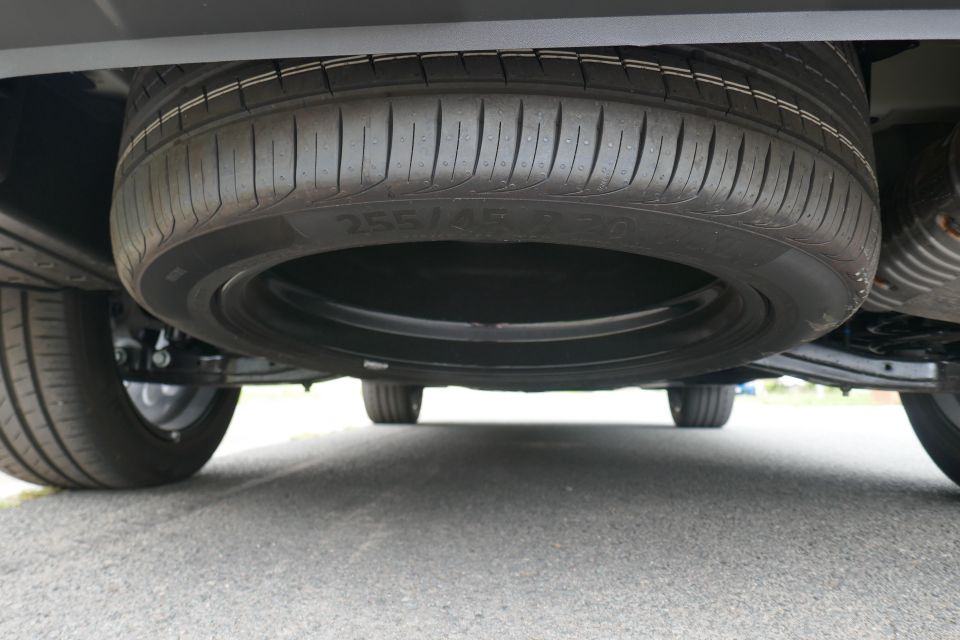
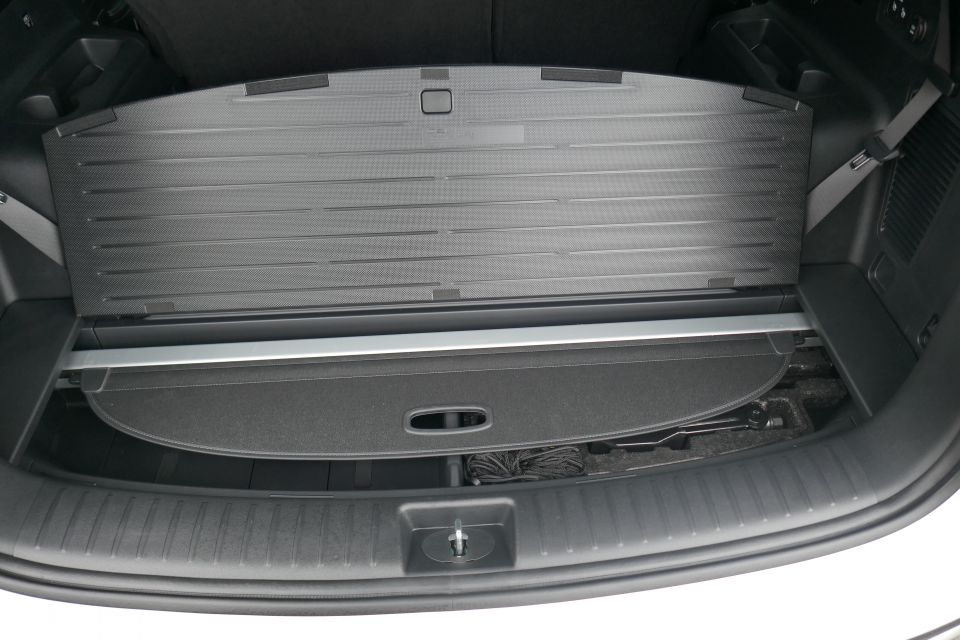
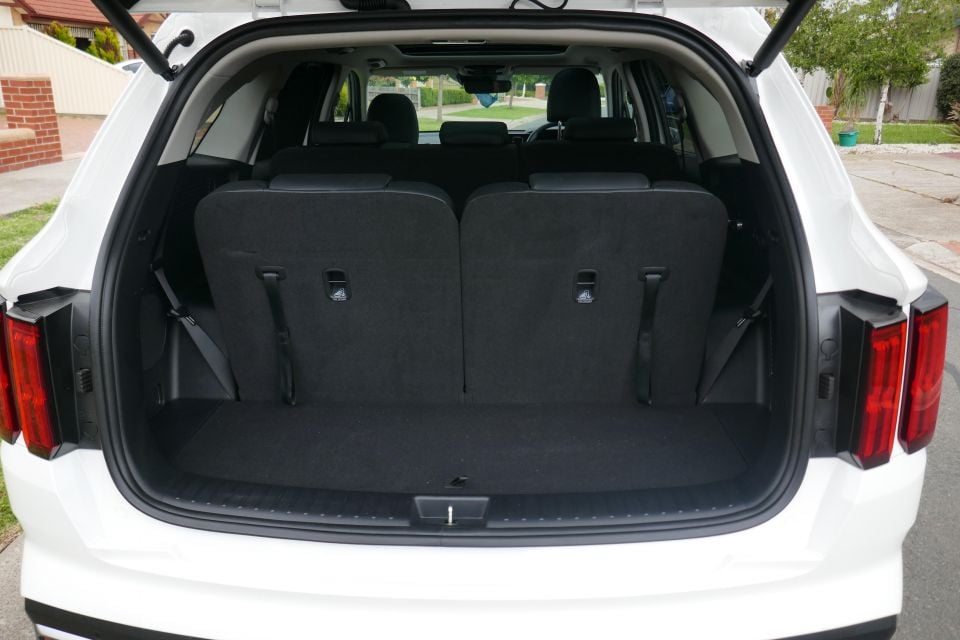
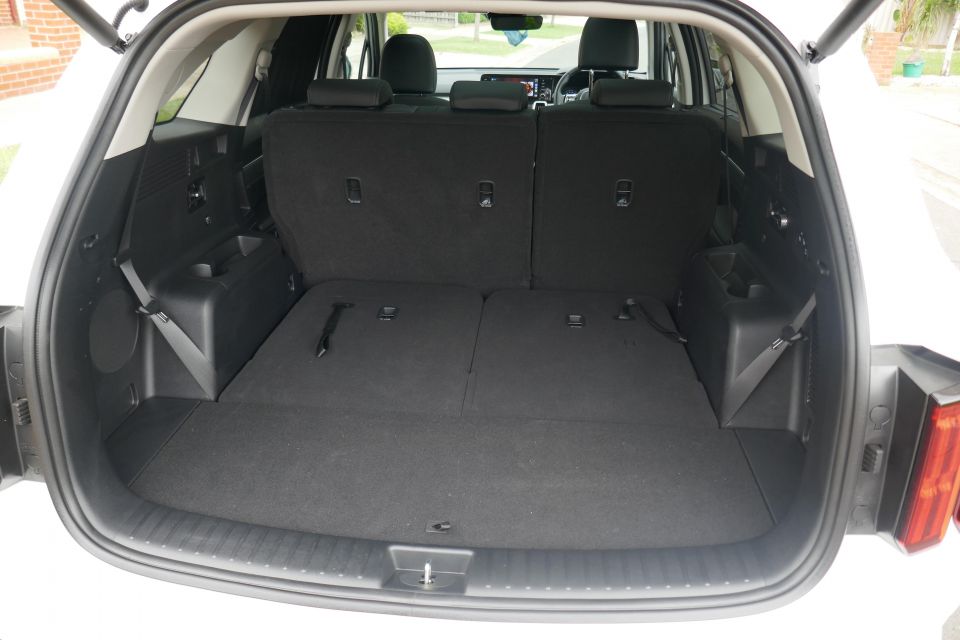
Space back there is surprisingly good, with sufficient headroom and legroom for smaller adults. Even I could bear it at a pinch.
Amenities in the rearmost row include vents at your side with their own analogue on/off/fan speed controls, two USB points (meaning there are eight in the car), and cup holders. The plastics are hard and far from tactile, but the sixth and seventh seats are really best for occasional use anyway.
Visibility out is hindered by the small side windows and large D-pillar, and it’s essential to mention that the side-curtain airbags do not cover the entirety of the third row in a side-on collision. That’s unfortunate, irrespective of a rigid body shell.
With all seven seats in use, cargo space is 187L, in real terms sufficient for a 30 litre esky and a few slabs of beer on either side. When not in use the third row seats fold neatly into the floor, upping cargo space to 616L.
To Kia’s eternal credit there is storage for the sliding cargo cover to be tucked away neatly under the loading floor. Moreover, folding the second-row seats flat is as simple as pressing buttons mounted next to the rear 12V socket.
There’s also a full-size spare mounted under the car, which is an excellent feature for high-milers.
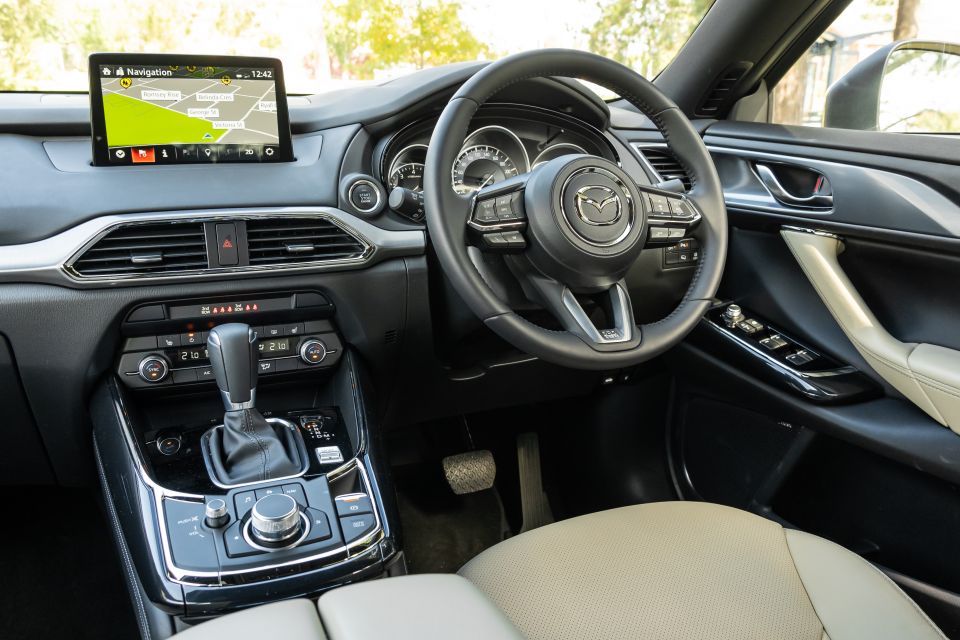
Mazda CX-9 GT
If the Kia is an ultra-modern tech showcase, the CX-9 makes a distinctly different first impression. The instruments are largely analogue, though the right-hand-side circle has a small digitised screen embedded. There’s a head-up display, allowing access to a digital speedo.
The cream-coloured Natural Stone leather keeps cool in summer but might be a pain in the proverbial to keep clean. Fortunately, Mazda offers black leather as well. The trim is supple, and offers heating and power adjustment. Less functionality than the Kia but no less comfy.
The highlight among the CX-9’s storage options is the Mercedes-Benz GLC-style split centre console, which has a beautifully tactile closing and opening mechanism. You also get a cubby below the fascia, decent door bins, cup holders, and sizeable glovebox.
The build quality is on par with the Kia, and the materials chosen sit on a higher plane. The padded transmission tunnel (nice on the knees), knurled dials, nice carpet, damped buttons, and the multiplicity of trim choices, all impart a more luxurious feel from behind the wheel.
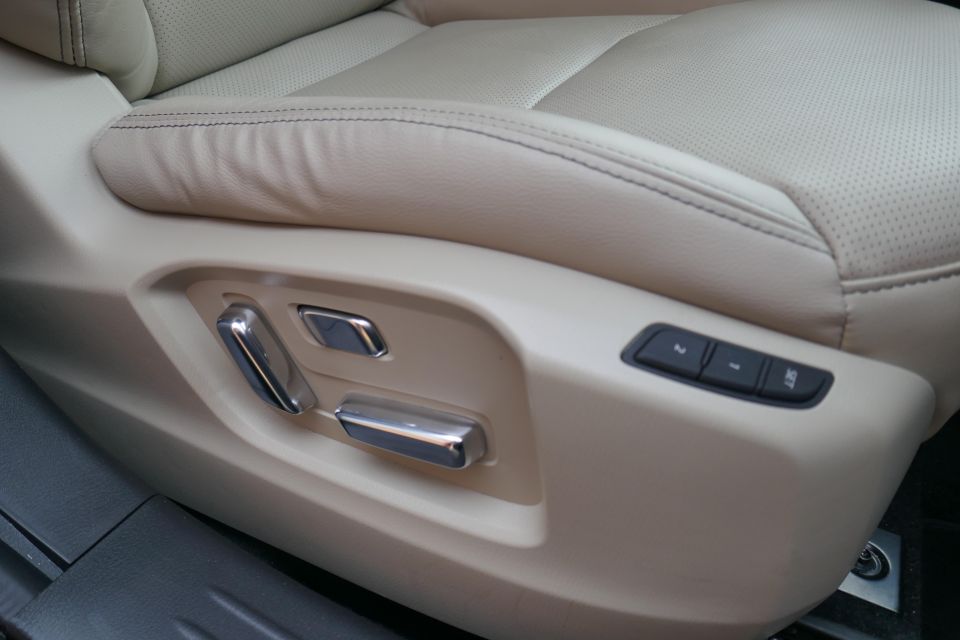

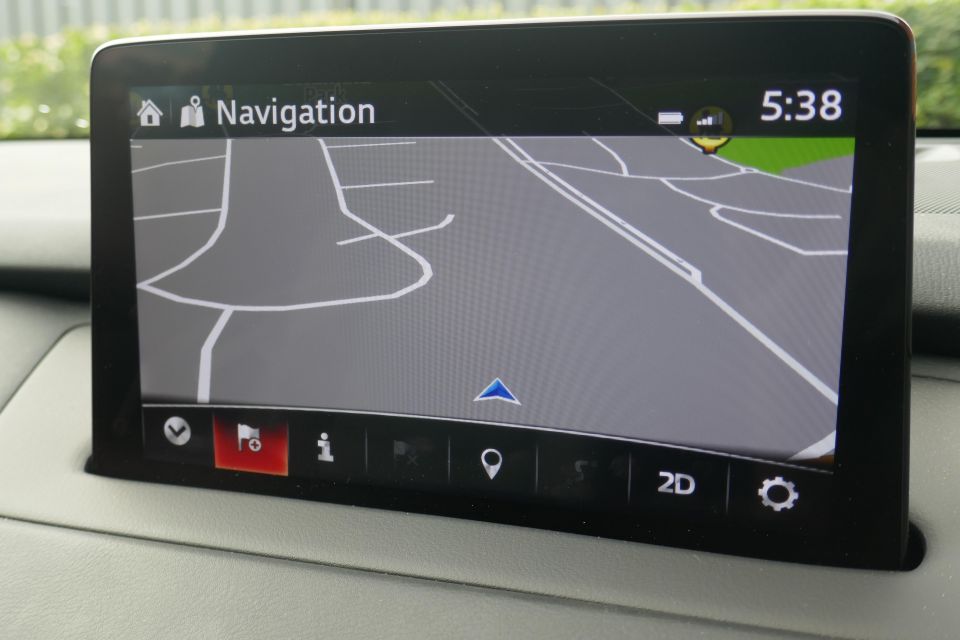
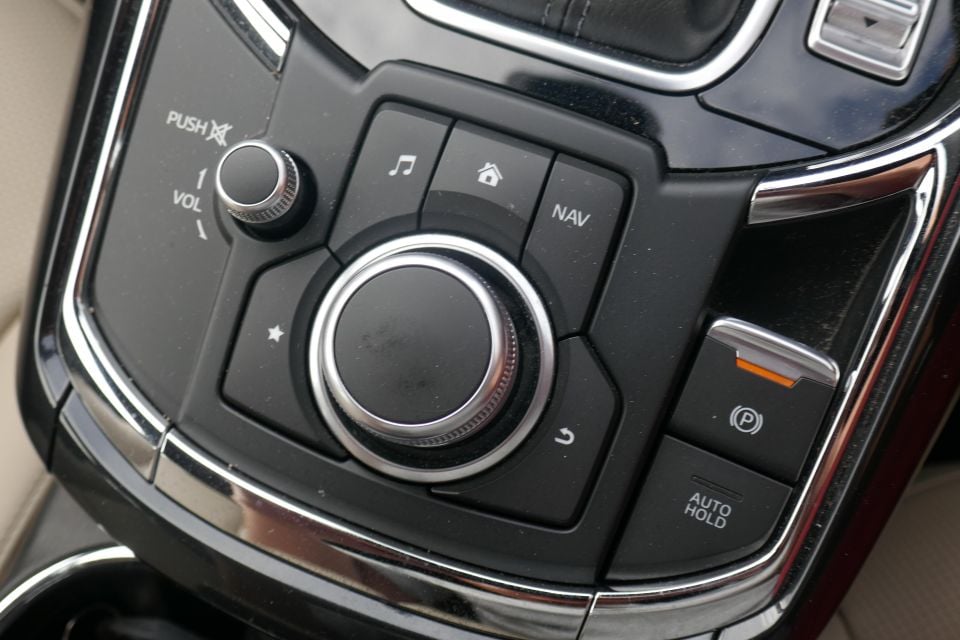
Like the Kia, there’s too much dust-prone glossy black, but you must be sick of me complaining about that by now…
Where the Mazda cedes ground to the Kia is tech. The centre screen isn’t small, but it’s running an older software system with more dated graphics and less functionality.
The maps appear a little simpler, the reversing camera is grainier, and you must revert to the rotary dial controller once rolling – even if you’re using touchscreen-friendly Apple CarPlay or Android Auto.
The CX-9 has not yet adopted Mazda’s newer infotainment system, as found in the smaller and cheaper Mazda 3 and CX-30. Hopefully an update that’s on the cards for 2021 rectifies this issue.
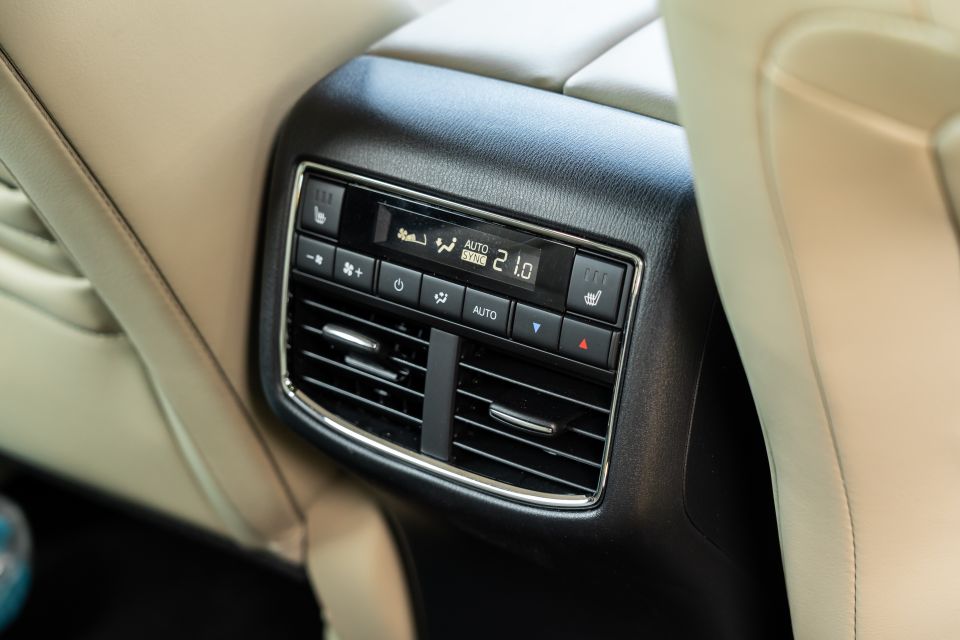
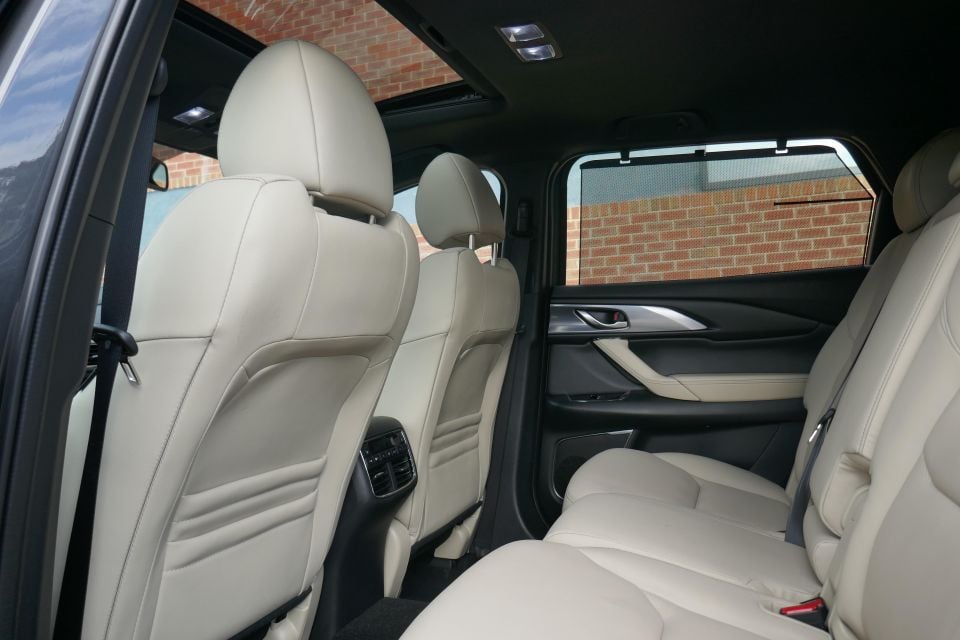

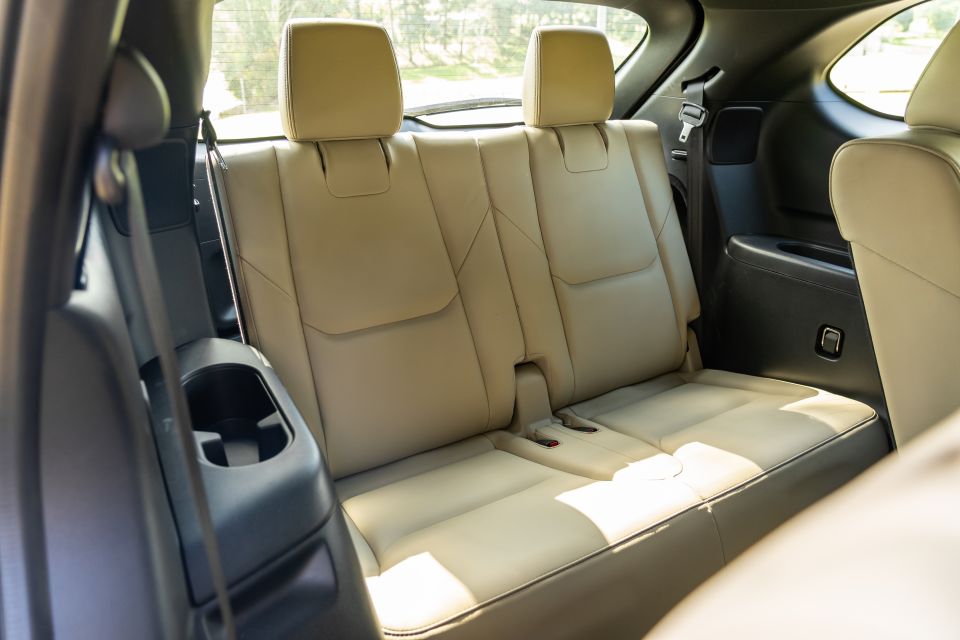
Thankfully, its Bose audio system is superb, and because of Mazda’s superior sound insulation and that luxury ambience, it actually sounds even more orchestral than the Kia’s.
If the Kia feels like a car designed for Silicon Valley tech heads, the Mazda’s layout is more reminiscent of a comfortable lounge chair surrounded by books and a fireplace. It’s this divergence in ‘personalities’ that most clearly separates these two competitors.
While the CX-9 is the longer vehicle, rear legroom isn’t demonstrably better or worse, though the smaller sunroof that only loops in the driver and passenger does create a moderately duller ambience. You sit up quite high, the seats are well-trimmed and offer an adjustable backrest, and slide on rails.
Like the Kia, the Mazda’s middle-row occupants get pull-up sunblinds and LED reading lights, as well as their own rear vents and heated outboard seats. The middle seat’s backrest flips down, and offers integrated USB points, cupholders, and a shallow felt-lined storage area. The double seatback storage pockets are a nice touch.
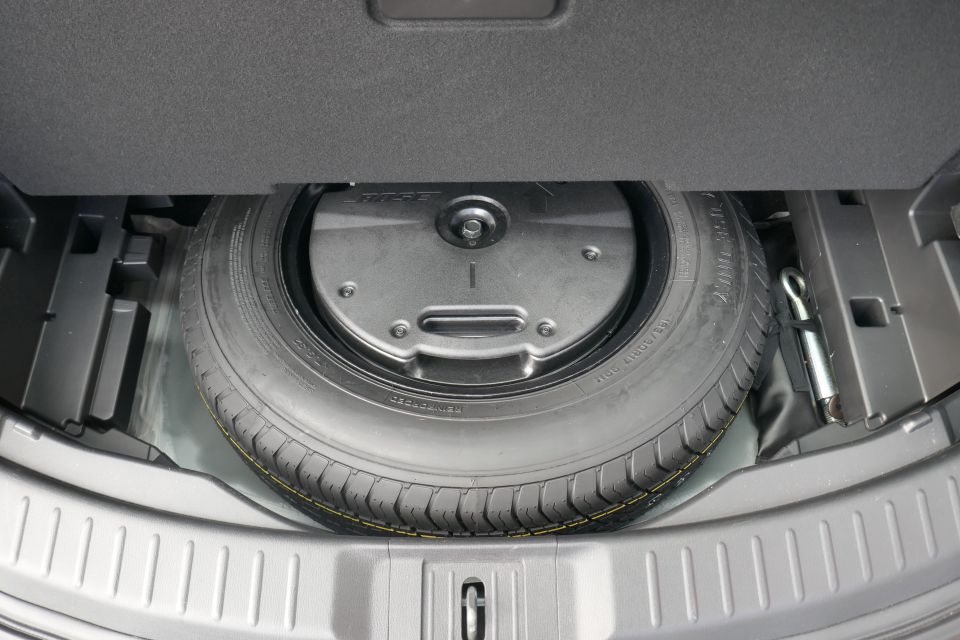
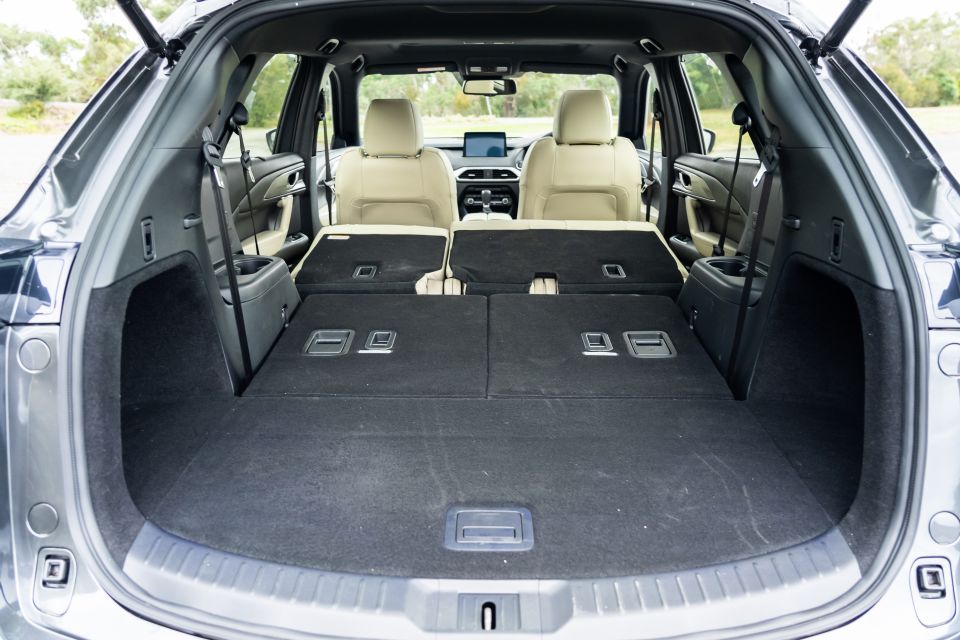


Opposite to the Kia, the larger portion of the 60:40 folding middle bench is located on the driver’s side, meaning kerbside access to the third row is through a smaller aperture. The push of a button elegantly folds and slides either portion out of the way, allowing access to the third row.
The space back in the rearmost row is acceptable for kids or smaller adults, but capable of housing larger people for shorter trips at a pinch. There’s little to no clear space advantage in the third row in the Mazda over the Kia, though its side airbags cover all rows. Like the Kia there are rearmost USBs, but unlike it there are no vents.
Where the Mazda’s extra body length is made most clear is its bigger boot. There’s an extra 43L behind the third row, and nearly 200L more storage room with this third seating folded flat into the floor (and retractable via solid handles). This loading area is 170mm longer than the Kia’s. The spare wheel is a space-saver.
Conclusion
The Kia has far more modern technologies, and is cleverly packaged despite its smaller footprint. The Mazda’s interior feels a little more lavishly tactile despite its older-world tech, and its boot is more practical.
| Kia Sorento GT-Line | Mazda CX-9 GT | |
|---|---|---|
| Length | 4810mm | 5075mm |
| Width | 1900mm | 1969mm |
| Height | 1700mm | 1747mm |
| Wheelbase | 2815mm | 2930mm |
| Ground clearance | 176mm | 222mm |
| Boot (7 seats in use) | 187L (VDA) | 230L (VDA) |
| Boot (5 seats in use) | 616L (VDA) | 810L (VDA) |
| Load area dimensions (5 seats in use) | 1100mm long, 1070mm between wheel arches | 1270mm long, 1030mm between wheel arches |
| Load area dimensions (just 2 seats in use) | 2000mm long | 2140mm long |
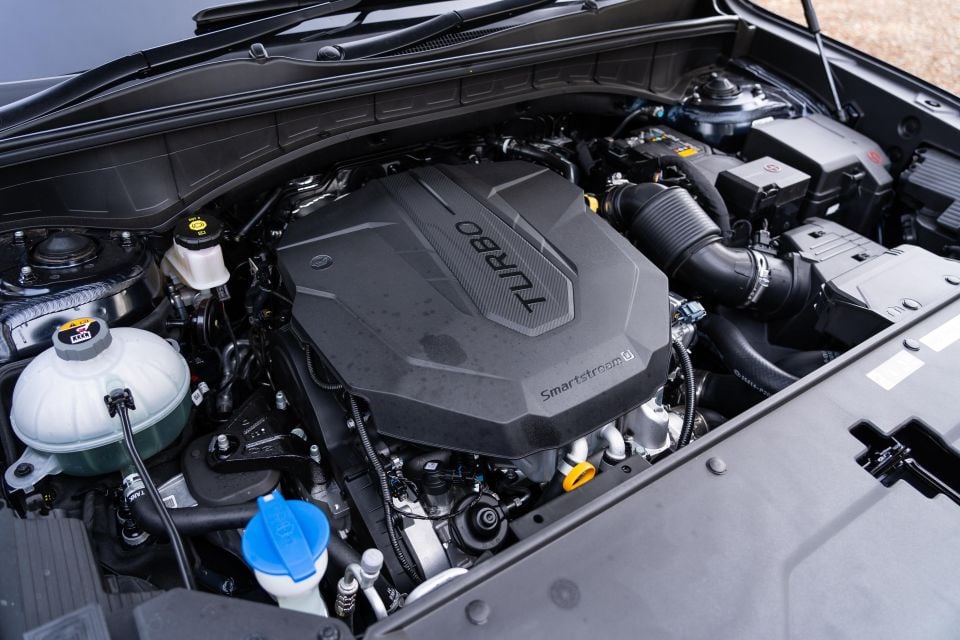
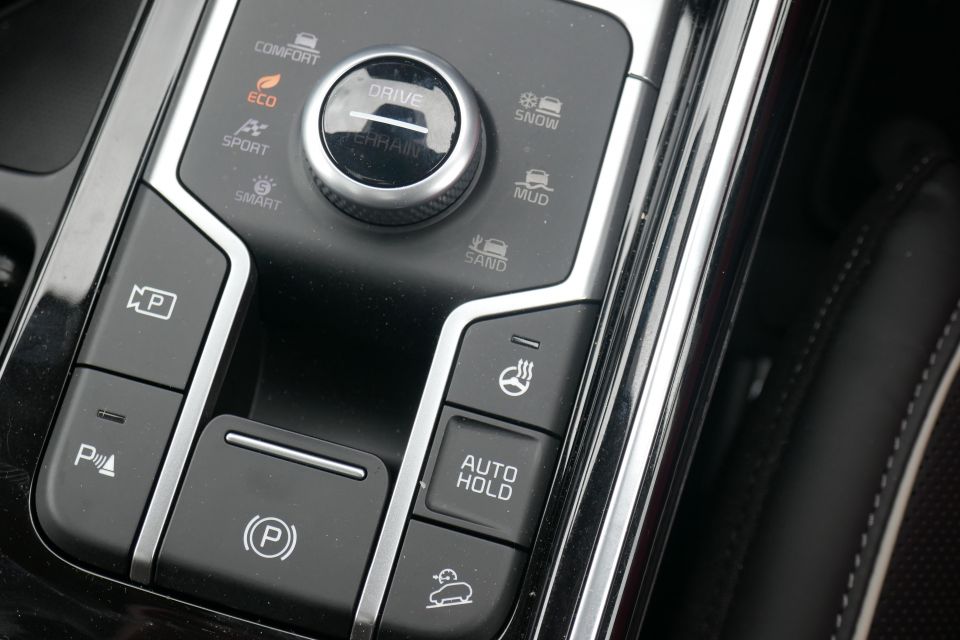
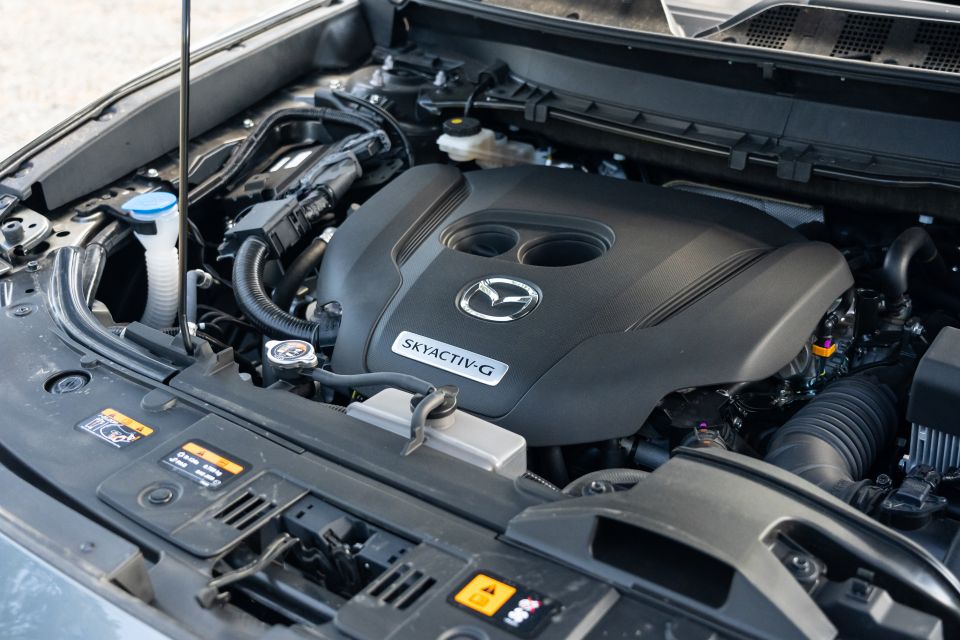
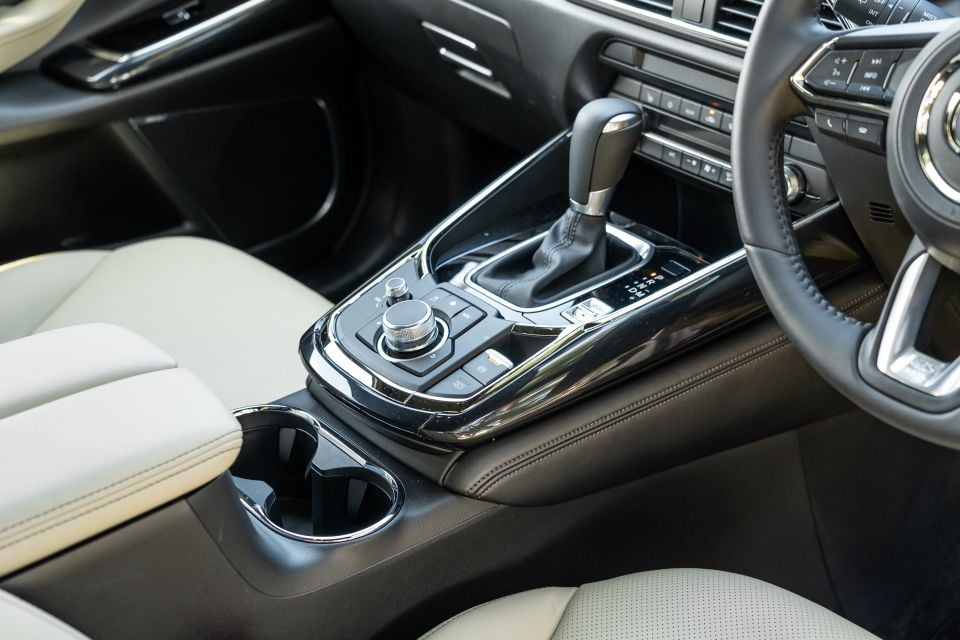
There’s a major difference in drivetrains. The Sorento in GT-Line form comes exclusively with a 2.2-litre turbo-diesel engine making 148kW of power and 440Nm of torque.
It’s mated to a new eight-speed dual-clutch automatic and an on-demand all-wheel drive (AWD) system that defaults to front-wheel drive until onboard sensors detect a loss of grip.
By contrast the Mazda CX-9 comes with a 2.5-litre turbocharged petrol engine making 170kW and a diesel-like 420Nm of torque (from way down at 2000rpm, nearly as low as the Kia).
It’s matched to a six-speed automatic and an on-demand AWD system.
The Kia’s fuel use claim is substantially better at 6.1 litres per 100km versus 9.0L/100km for the Mazda, though the latter happily runs on cheaper 91 RON fuel at least. Both also have 2000kg towing capacities.
If you want alternative power, the Kia comes with a $3000 more affordable 200kW petrol V6 option, but only with FWD. In 2021 Kia promises to deliver both ‘normal’ hybrid and plug-in hybrid (PHEV) options, as you can read about here.
The Mazda CX-9 comes with no other engine, though the slightly smaller Mazda CX-8 (a seven-seat version of the popular CX-5) comes with diesel power as an option.
| Kia Sorento GT-Line | Mazda CX-9 GT | |
|---|---|---|
| Fuel type | Diesel | Petrol 91 RON |
| Displacement | 2.2-litre | 2.5-litre |
| Cylinders | 4 | 4 |
| Power | 148kW @ 3800rpm | 170kW @ 5000rpm |
| Torque | 440Nm @ 1750rpm | 420Nm @ 2000rpm |
| Transmission | 8-speed DCT auto | 6-speed auto |
| Driven wheels | All-wheel drive | All-wheel drive |
| Fuel cons. claim | 6.1L/100km | 9.0L/100km |
| Fuel tank | 67L | 74L |
| Towing capacity | 2000kg | 2000kg |
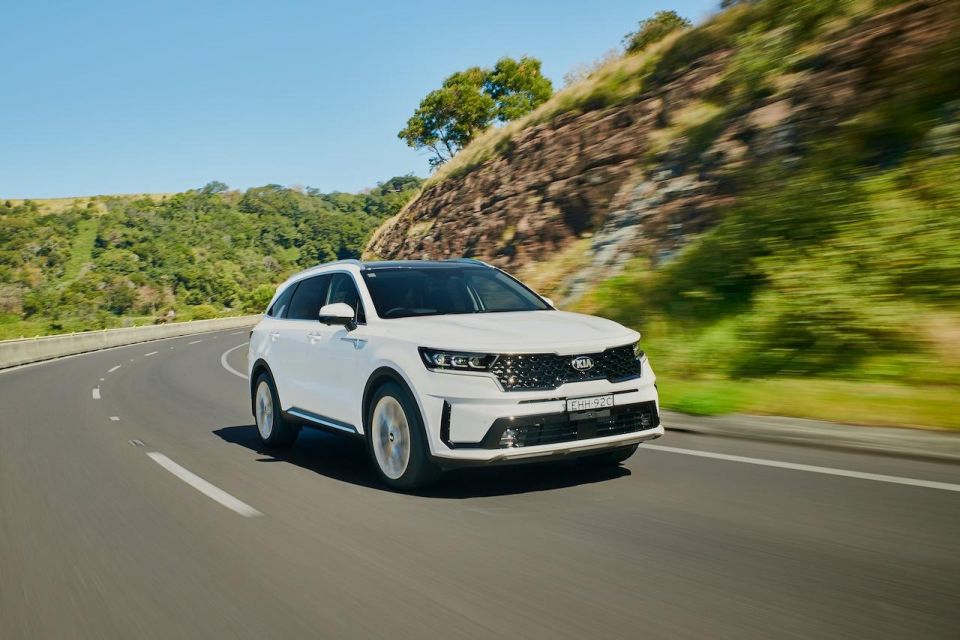
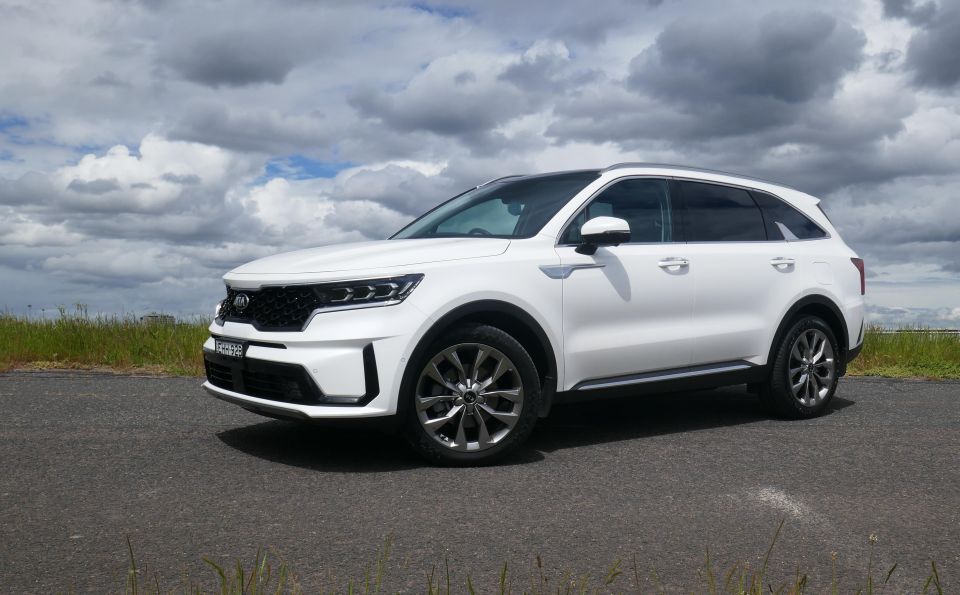
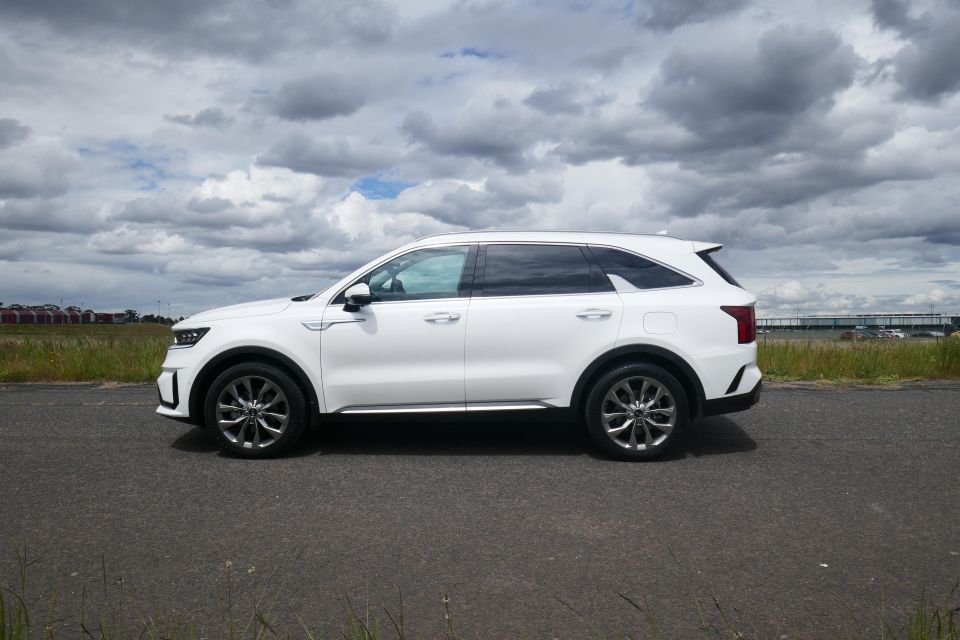
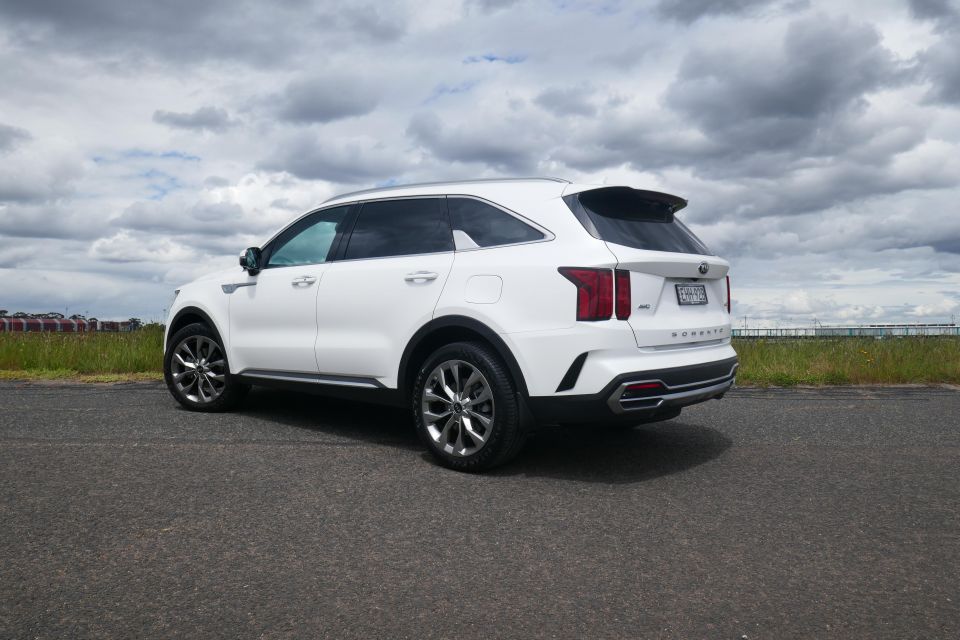
Where expert car reviews meet expert car buying – CarExpert gives you trusted advice, personalised service and real savings on your next new car.
Kia Sorento GT-Line
The engine is refined and free of harsh clatter from inside, though you won’t mistake it for a petrol or hybrid. You have strong response because so much torque is available just above idle, and it makes short work of hills or punching into gaps.
The various driving modes don’t make a great deal of difference, though the DCT holds lower gears in Sport, allowing the engine to rev out a little more.
That transmission is clever because the drivetrain holds slightly higher-than-expected revs on take-off, which seems to mitigate any low-speed harshness that you sometimes find in dual-clutch setups. And once you’re rolling, shifts are rapid and decisive.
I ticked off a 0-100km/h dash in 9.4 seconds and over a 200km mixed loop including lots of urban traffic time, managed a respectable 8.4L/100km fuel readout. That’s a fair whack more than the claim, but not bad for something this hefty.
This is perhaps a controversial view, but I do think Kia should’ve fitted a stop/start system to switch the car off at traffic lights. In school zones for example, I don’t love the idea of the diesel chugging away at idle, and can see a time when you’d like a little silence and no NOx particulates.
There’s a new monocoque, with a stiffer body shell. The MacPherson strut front and multi-link rear suspension have been tuned in Australia for local conditions, meaning specific calibration of components like dampers, and particular spring rates and stabiliser bar thicknesses.

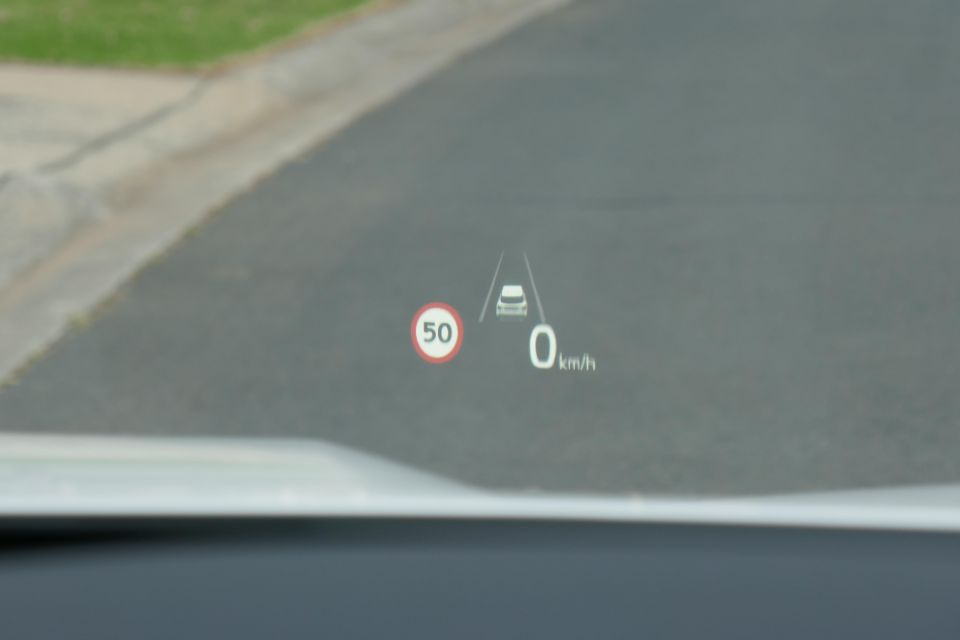
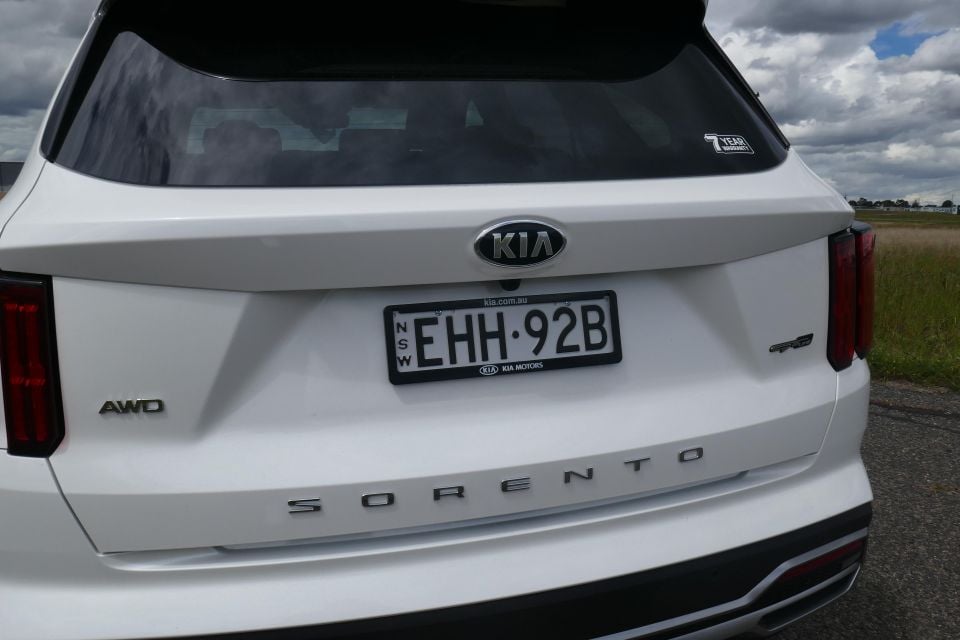
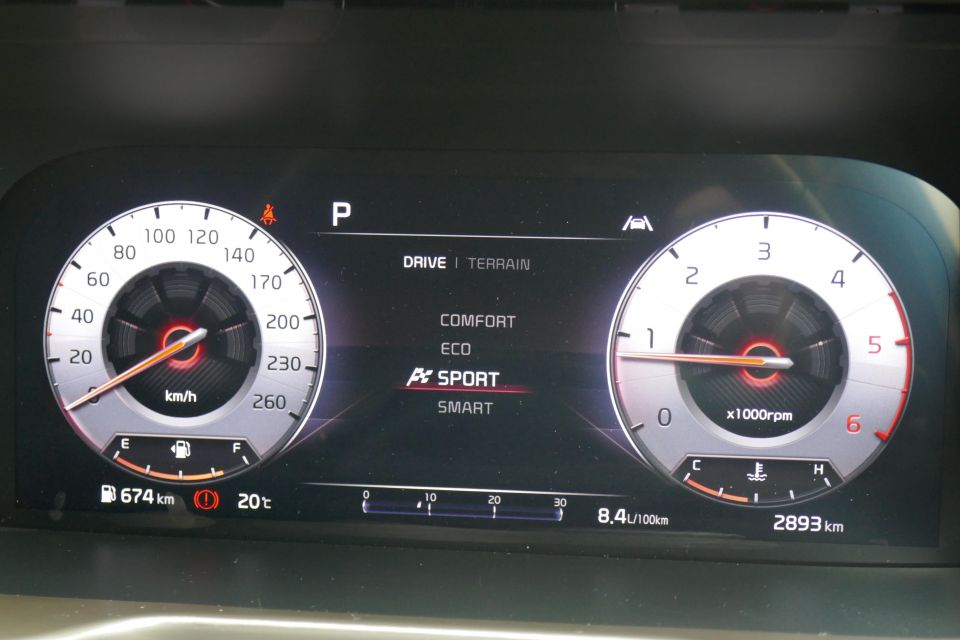
There are 325mm-diameter ventilated disc brakes at both ends, which give reassuring stopping power.
It’s a delightfully nimble seven-seat SUV actually, with light yet responsive steering (meaning it quickly responds from centre), well tied-down body control through corners, and a generally compliant ride quality – though the ride at low speeds is occasionally jarring due to the slim-sidewall tyres wrapping the 20-inch wheels.
Despite the presence of on-demand AWD with a locking mode, various terrain modes, and even downhill-braking control, don’t mistake the Sorento for a body-on-frame off-roader like a Mitsubishi Pajero Sport, Toyota Prado, or Ford Everest.
It has road tyres, only 176mm of ground clearance, no locking rear differential, and no low-range gearing, so it’s a soft-roader only. But for snow trips, the odd light-duty trail, or a boat ramp, it should be in its element.
One final note: the Kia has a remarkable remote control function, like a watered-down take on Tesla’s Summon Mode. By holding a button on the key fob, you can remotely start the car and drive it backward or forwards out of a parking bay, which is very helpful if some numpty has parked too close to you, to allow easy cabin access.
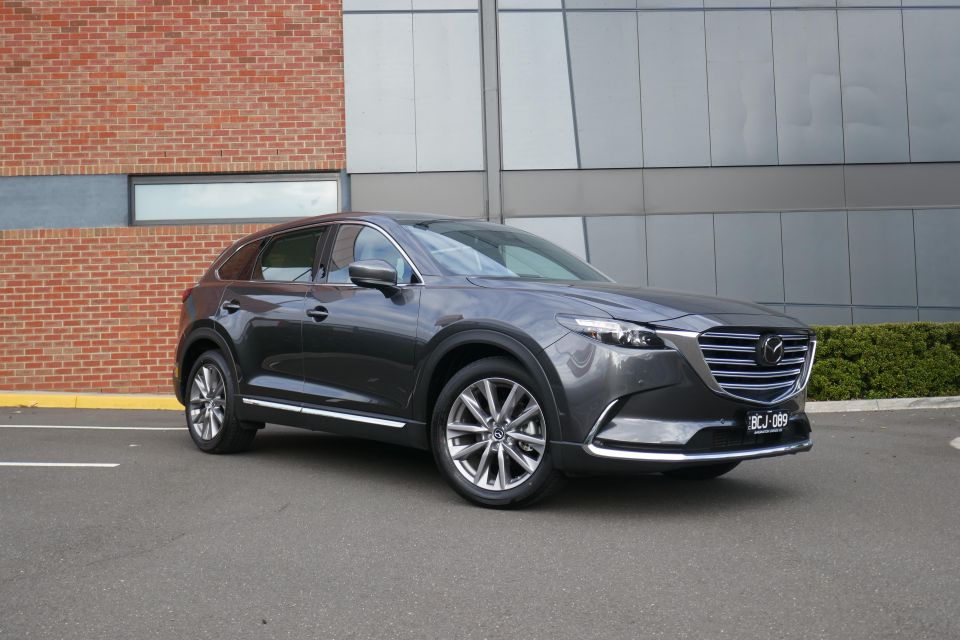
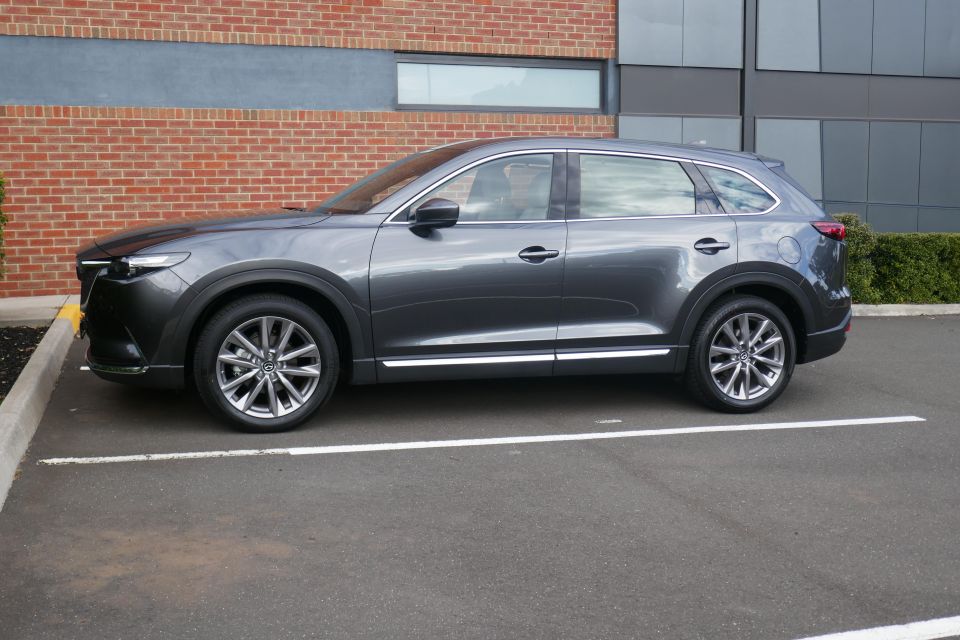
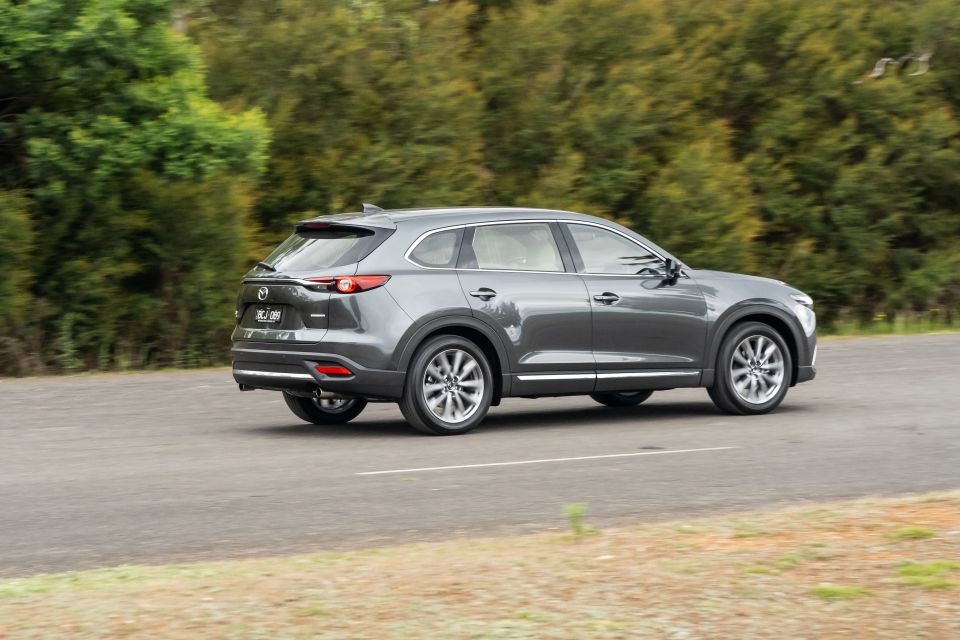
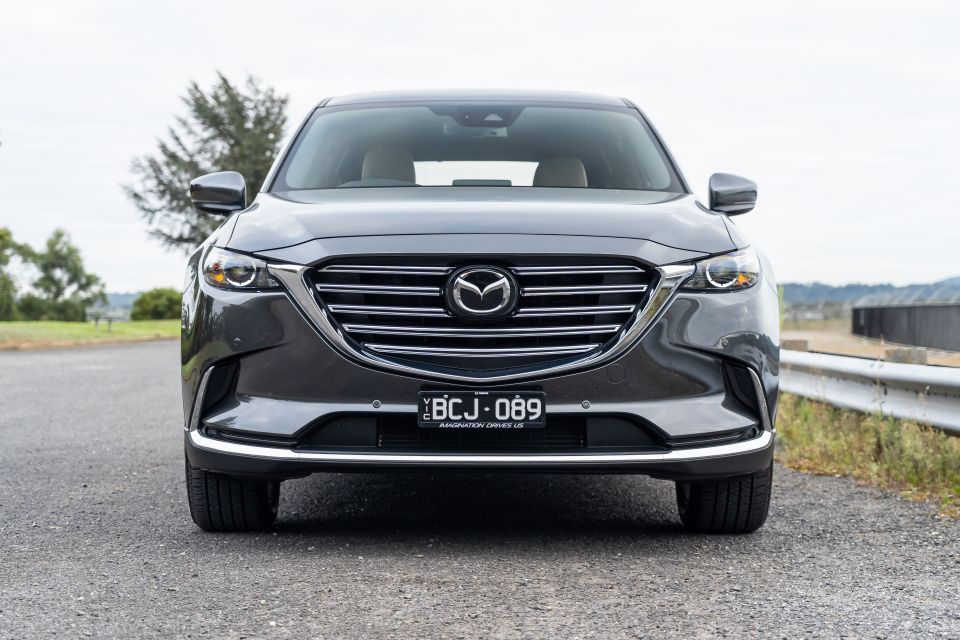
Mazda
The Mazda’s petrol engine is a little quieter and more refined than the Kia’s under acceleration, and thanks to its broad wedge of torque actually feels nearly as muscular.
The automatic transmission has two fewer ratios to use and shifts a little more slowly between them, but Mazda has done a good job spacing them out. The little rocker switch labelled Sport programs in some incongruously aggressive downshifts.
It gets you from standstill to 100km/h in about 8.0 seconds, so is quicker than the Kia despite an extra 100-odd kilos of mass. Where it impressed me more was fuel economy: I managed 9.5L/100km, much closer to the factory claim and not spectacularly less efficient than the diesel Kia.
Again, my own view only, but the presence of a switchable engine stop/start system suits this sort of car, and sitting in traffic in silence with the A/C running is always more relaxing. The engine reboots swiftly and the CX-9 gets rolling quite smoothly.
The Mazda has the same fundamental suspension layout as the Kia and similarly sized brakes, though the pedal feel is fractionally doughier. It still pulls up reassuringly despite its mass.
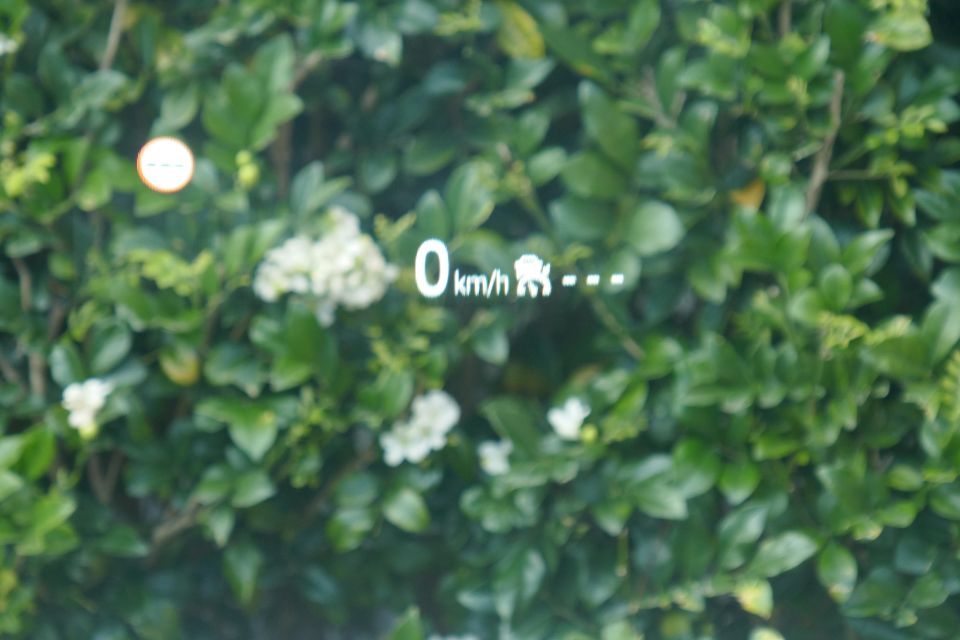
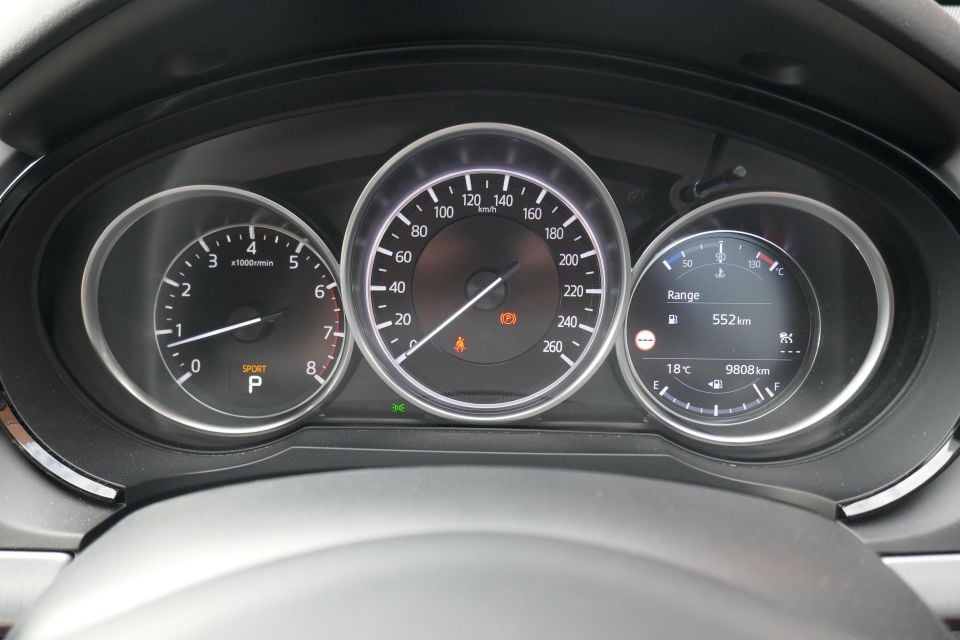
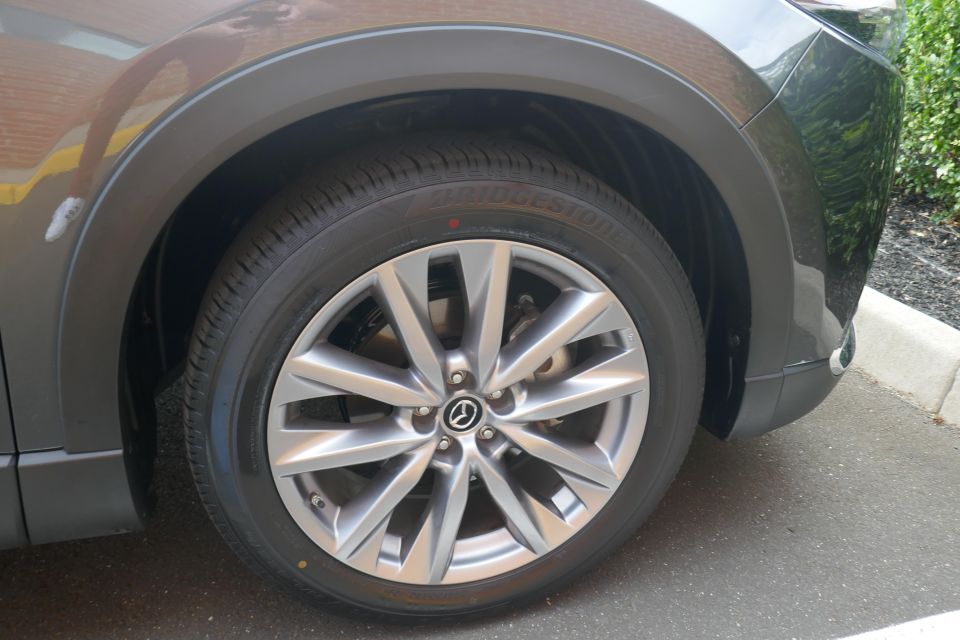
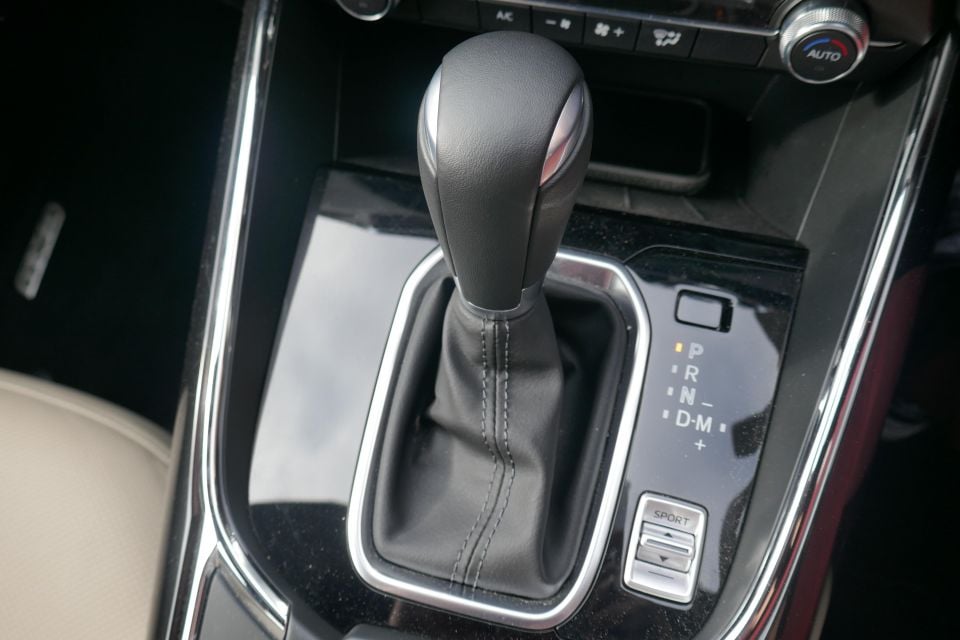
One of the biggest obvious differences against the Kia is the tune of its electric-assisted steering. There’s a weightier feel with more resistance, and though the turning circle is scarcely inferior, the longer Mazda does feel less wieldy at low speeds and less agile at a higher clip.
On the other hand, it insulates and cossets occupants from tyre and wind noise a little better, and smooths out low-speed sharp hits like speed bumps just a smidgen more effectively. Lower-grade Sorentos with fatter tyre sidewalls change this equation again, but we’re not testing those here!
The on-demand AWD system works similarly to the Kia’s, though there aren’t the same surface driving modes to change the throttle/ESC tune. If you never drive to the snow or on grass footy grounds in winter, perhaps you needn’t worry about it at all.
Therefore you can buy the CX-9 with front-wheel drive (FWD) and save yourself a cool $4000, though from memory these versions light up (spin and tramp) the front wheels a little too easily on a wet day.
| Kia Sorento GT-Line | Mazda CX-9 GT | |
|---|---|---|
| Wheels | 20-inch | 20-inch |
| Spare | Full-size alloy | Temporary |
| Kerb weight | 1908kg tare | 2006kg kerb |
| Front suspension | MacPherson strut | MacPherson strut |
| Rear suspension | Multi-link | Multi-link |
| Front brakes | 325mm ventilated disc | 320mm ventilated disc |
| Rear brakes | 325mm ventilated disc | 325mm solid disc |
| Turning circle | 11.6m | 11.8m |
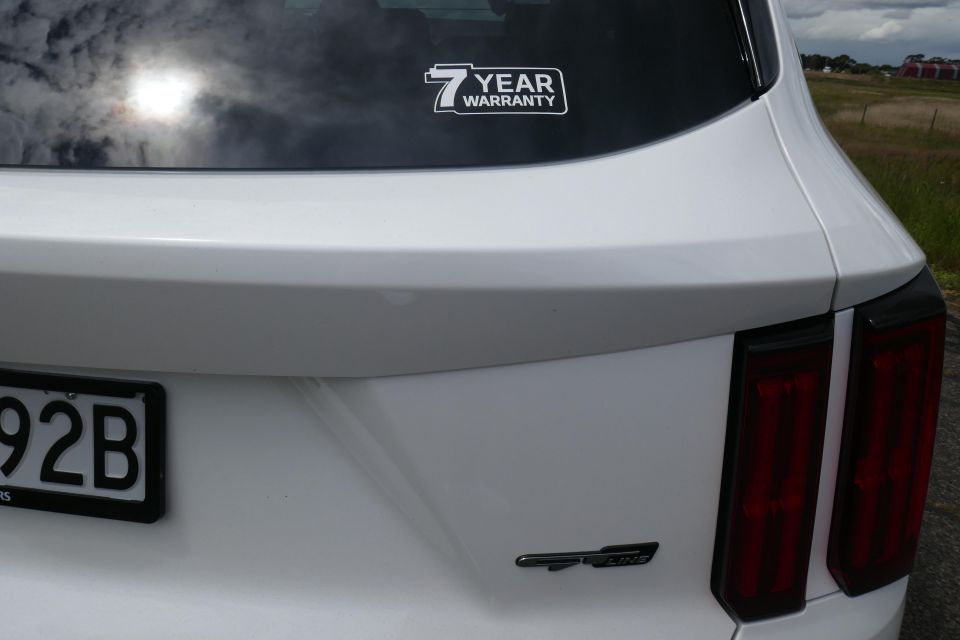
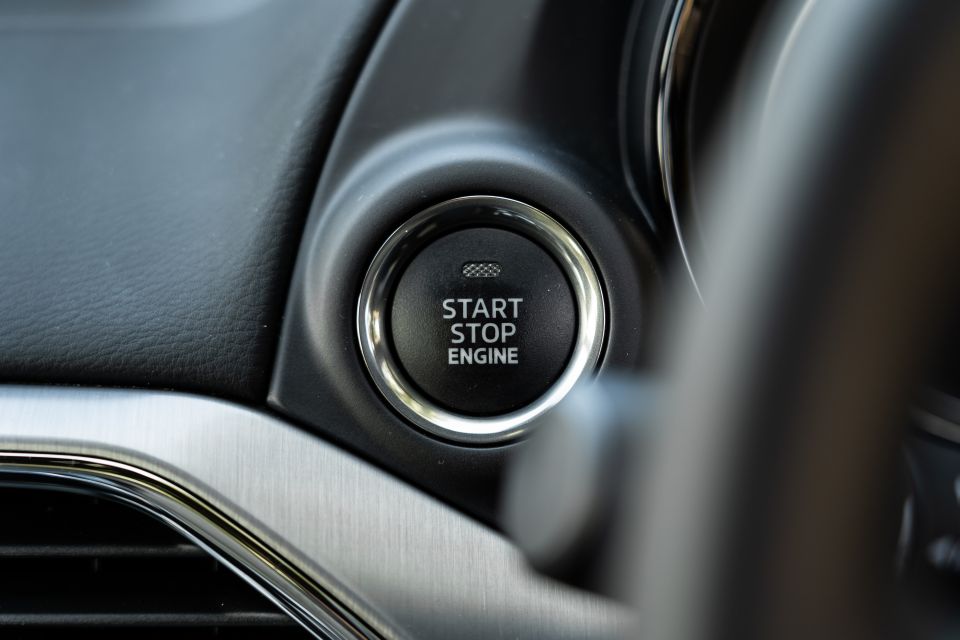
Kia has a seven-year warranty versus five years for the Mazda. Neither have distance limits.
The Sorento’s service intervals are annual or 15,000km (whichever comes first), and capped. The prices for the first five at the time of writing are: $335, $544, $408, $729, $377.
The CX-9’s intervals are annual or 10,000km, and capped. The prices for the first visits are: $363, $408, $363, $408, and $363. On top of this you need to pay $105 every 40,000km for a new cabin air filter and $96 every two years/40,000km for new brake fluid.
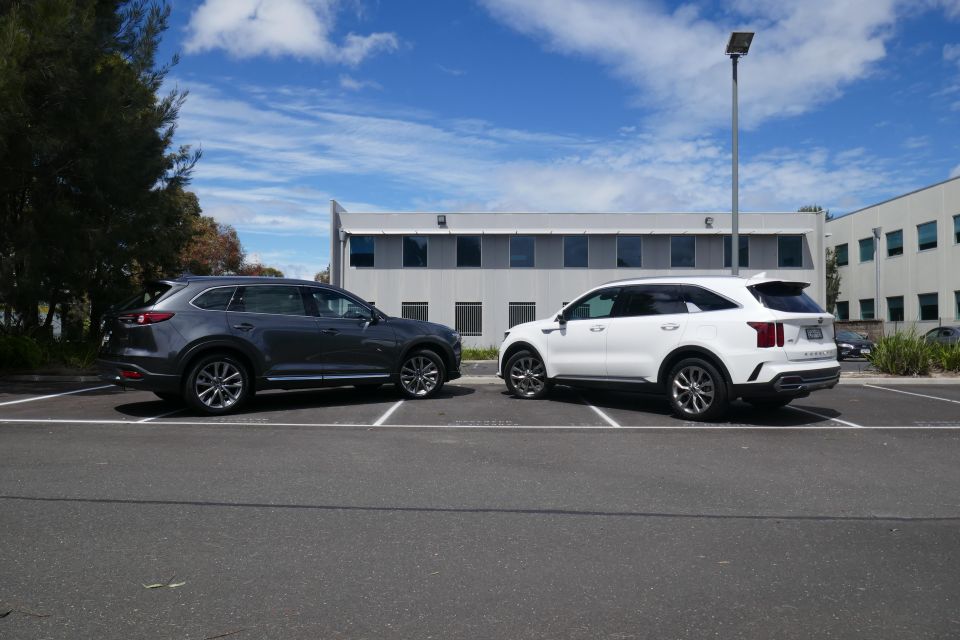
This is a truly difficult question to answer.
The Mazda has the edge in cabin practicality, and is a little more refined to drive both in terms of the drivetrain and road-noise insulation. That cabin is also beautifully tactile and invitingly comfortable.
On the other hand, the Kia belies its smaller dimensions with clever packaging, is still more fuel efficient, and offers more contemporary cabin technologies and active safety functions. Then there’s its longer warranty and service intervals to consider.
My final answer is this: if you’re buying a seven-seat SUV and plan to regularly use the third row, then the Mazda remains a better option. But if you need a ‘5+2’ family hauler, the Kia’s positive attributes strike me as more compelling. Personally, I’d choose the latter.
MORE: Kia Sorento news and reviews MORE: Mazda CX-9 news and reviews
Share your thoughts with us in the comments below!
Share your thoughts and write a review of a car you own and get featured on CarExpert.


CarExpert.com.au
3 Hours Ago


Damion Smy
16 Hours Ago


Damion Smy
19 Hours Ago


Damion Smy
23 Hours Ago


Damion Smy
1 Day Ago


Damion Smy
1 Day Ago